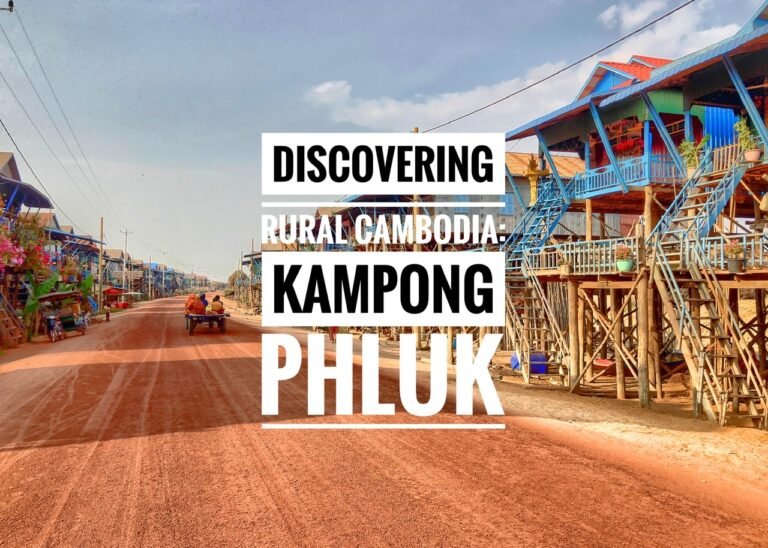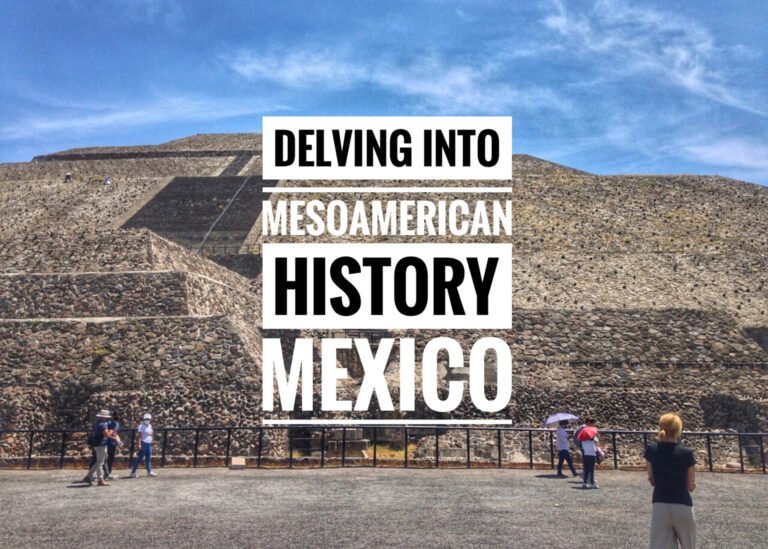
After a 10-year Pacific Northwest hiatus, it was finally time to be reunited with the city where it all began…where Greg spent seven years of his life as a professor at Charles University before meeting Mandy in 2007, who had recently moved there to be an English teacher. See that story. We were more than ready to return…to be wrapped in its magic again, reunite with old friends, and of course, venture out on new and familiar explorations.
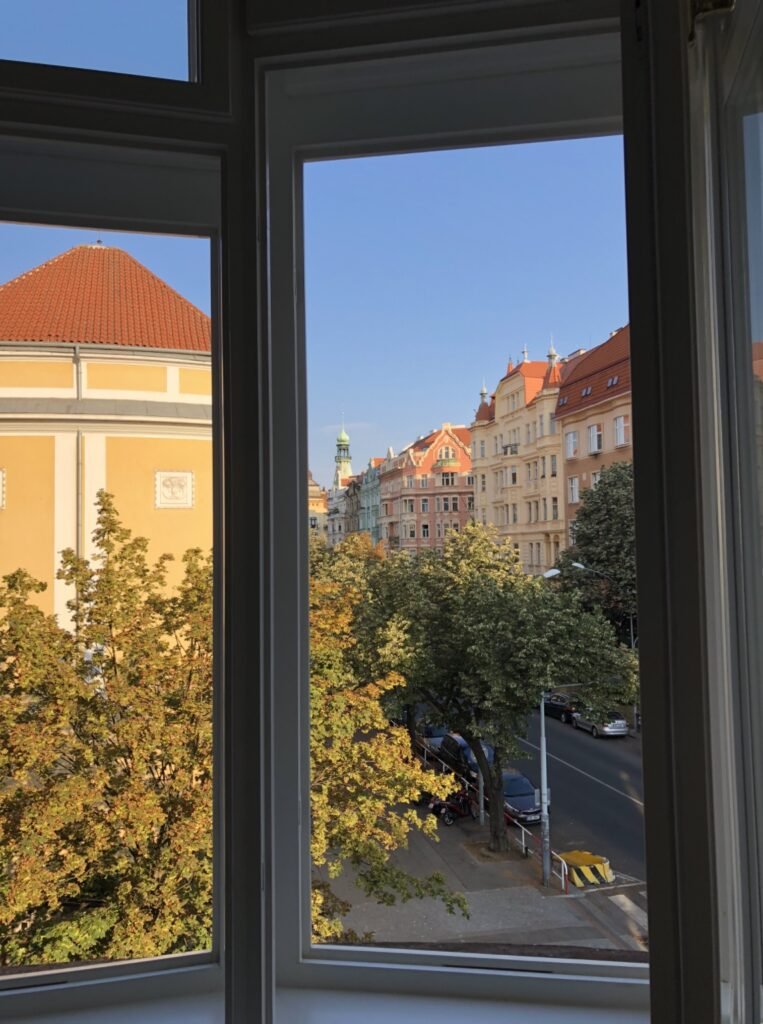
Upon arriving to the familiar airport with a new name (now Vaclav Havel, after the former Czech president), we hopped on the familiar bus which took us to the end of the green metro line. Because, ah yes, ten years have passed and yet the airport is still not directly connected to the airport.
Greg’s former colleague turned friend, Dan, met us at the stop near his home in Vinohrady, which is the neighborhood Mandy used to live in, and is now classified as “hipster” in Prague terms, at least according to Dan. We think this just means there’s now more prevalent facial hair and hip culinary options, including exotic delicacies like Mexican, which was completely off-the-radar for us in 2007. The view from our window the first night made us sigh repeatedly, not believing we were back.

Dan, who grew up in Washington State, like Greg, and his Czech wife Jana had graciously agreed to host us for the first few days of our reunion tour.
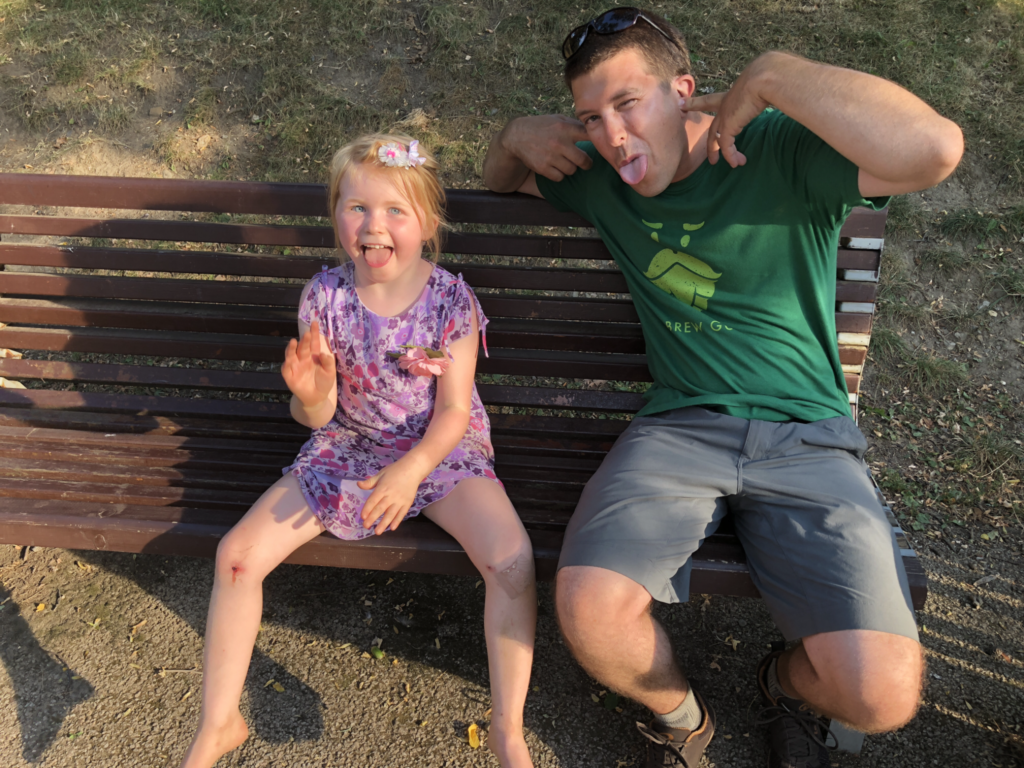
Dan and Jana also have two very cute kids. Since they were offering us a place to crash, we thought it might be nice to give them an evening off while we took Becky and Billy to the playground. Becky, who was five at the time, talked about a mile a minute and could transition masterfully from Czech to English, and both kids even threw in French here in there which they had been soaking in from a French cartoon called Peppa Pig. Kids are amazing. Can we please learn languages like that?
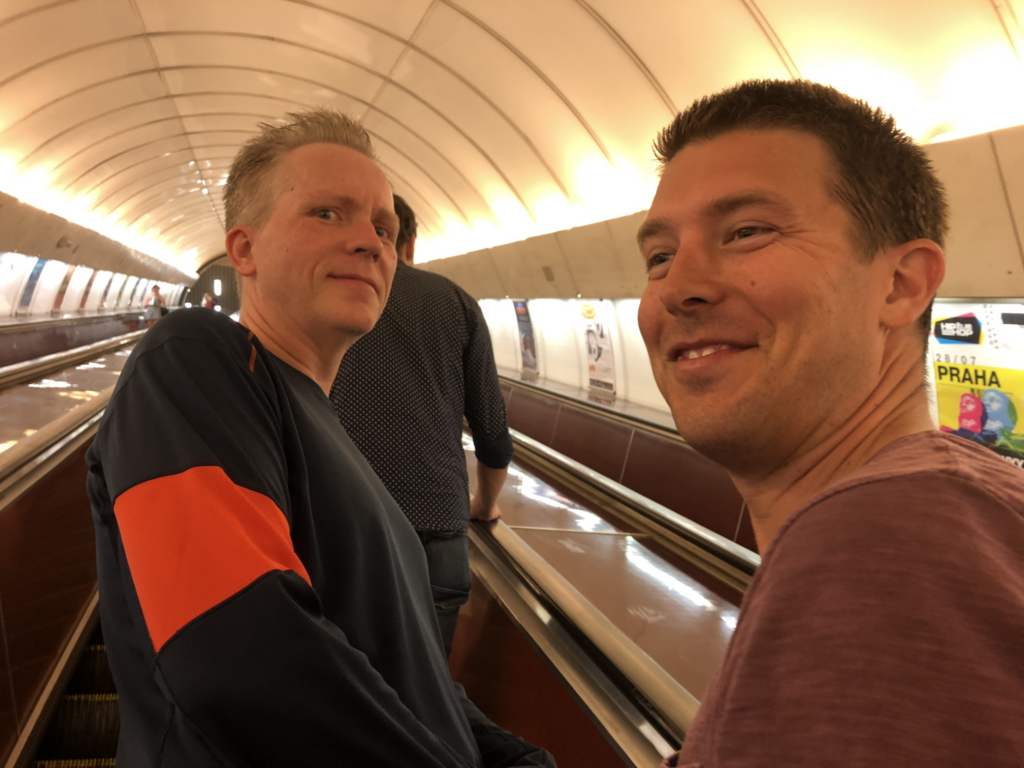
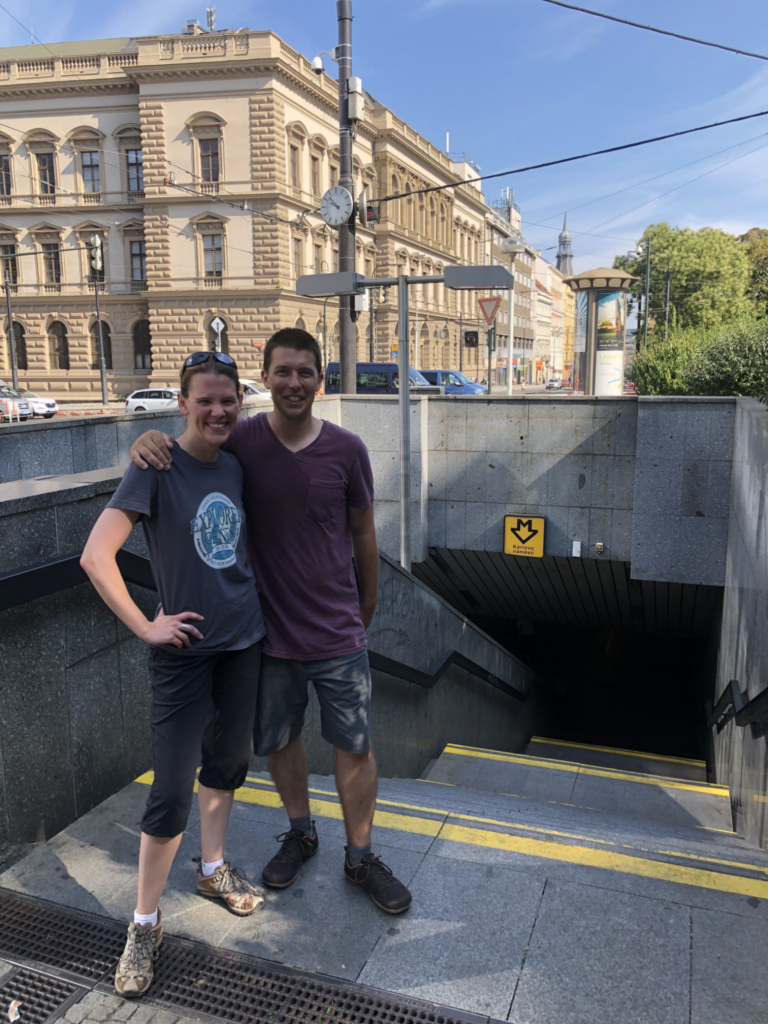
Dan didn’t let us wait long before we settled back into a “local” routine and he wanted us to go running with him in Vyhlidkove Misto, which is a natural area within Prague city limits, but feels as though it’s a world away. For us, just riding the metro and pausing on its endless escalators was all it took to bring back a cozy feeling of living-like-a-local nostalgia.

Petřín Hill
The run was incredible, but there was a place where Mandy was aching to return to. To the top of Petřín Hill. Here she was on the half hour slightly steep hike up in August 2007.


Ironically, on the way up, we happened to stumble upon the same tree Mandy had found in 2007. Fortunately, thanks to years of yoga, her posture had improved. 🙂
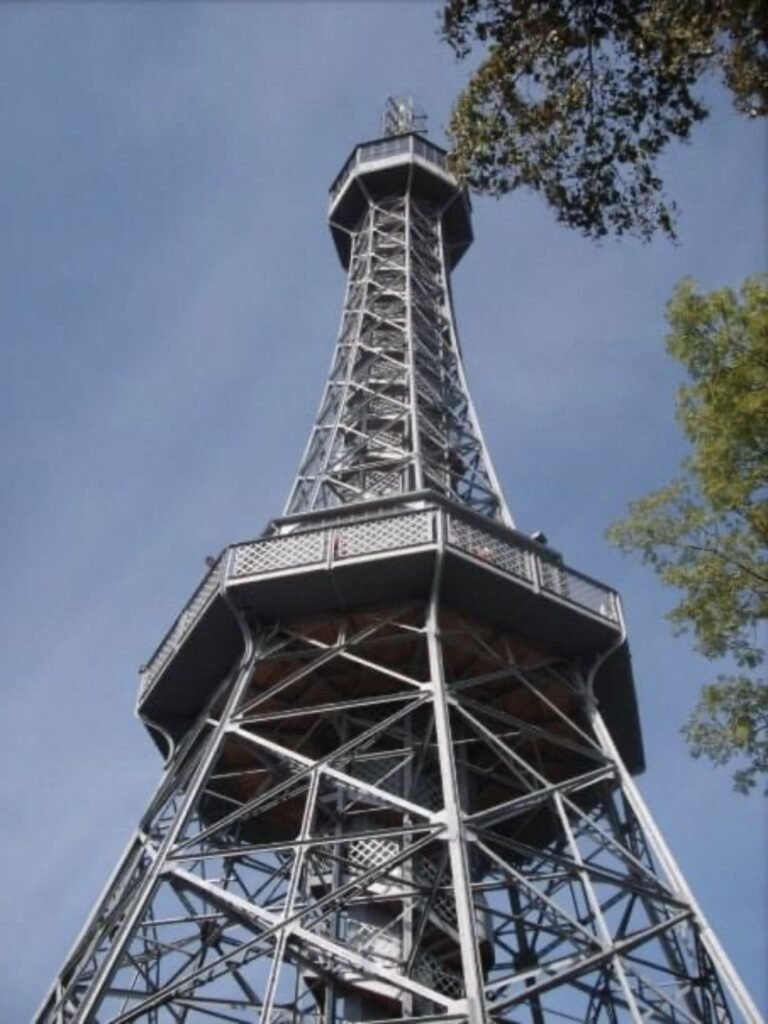
Petřín Hill is on the west bank of the Vltava River and perched on the top is the Eiffel Tower wannabe structure called, you guessed it…Petřín Tower, which is 63.5 metres (208 ft) and was built in 1891. In 1889, a group from tthe Club of Czech Tourists visited the World Exposition in Paris and were inspired by the original. They collected a sufficient amount of money and in March 1891 the building of the tower started for the World’s Jubilee Exhibition. It was finished in only four months.
It has an elevator, but only for those who are not “able-bodied.” If you’ve got two functioning legs, pretty much expect to traipse the 299 steps up to the top.
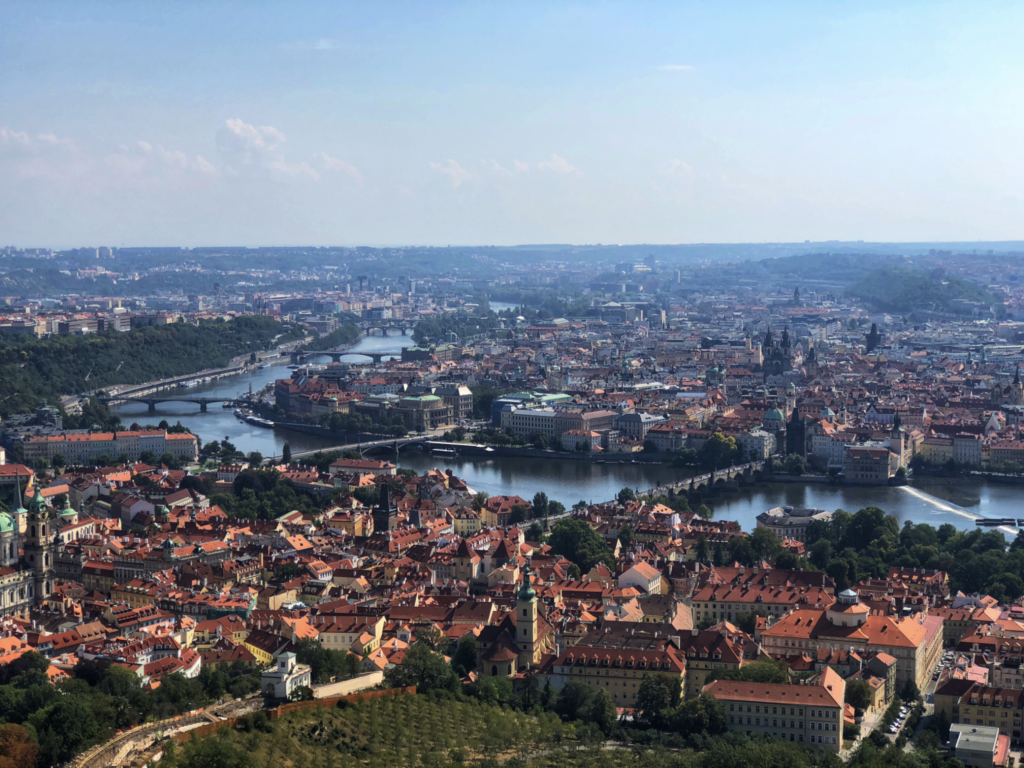
The reason this place is distinctive for Mandy is because when she first visited Prague in 2007, which was also her first solo trip and time out of the country, (because Mexico and Canada don’t count), she climbed to the top of this tower. It was here she encountered this view for the first time, the sweeping red roof tops, the bend of the Vltava and the endless tinker toy bridges and buildings. It was a view she’d never seen in pictures, and certainly in a place she’d never been.

Yet, while standing gazing at that view, she had the most mind-blowing, long-lasting deja vu that she couldn’t shake for nearly five minutes. It was at that moment, she knew without a shadow of a doubt, she was meant to move to Prague and take a drastic leap into the unknown. Turns out, this decision ended up being an absolute game-changer for her life…in the best way possible.
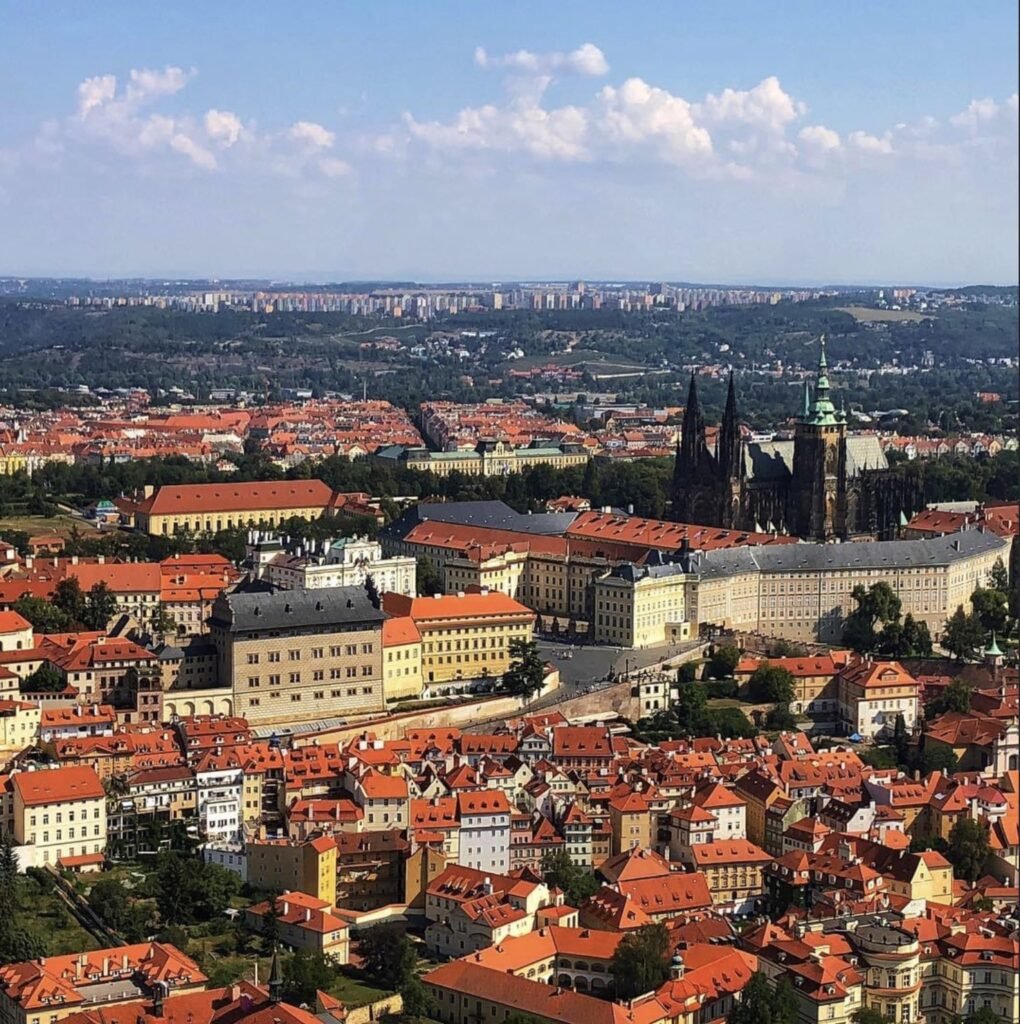
This view truly never does get old. We both constantly found ourselves wondering if we were really there again in this dream-like reality.
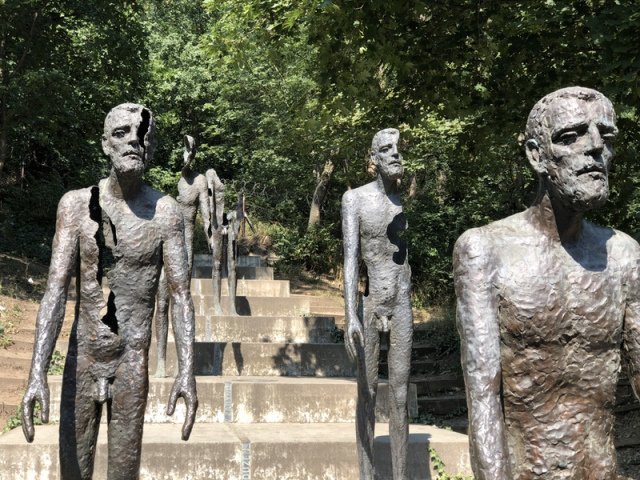
As you drop down from the hill, you’ll notice an eye-catching set of statues, which depicts Prague’s Memorial to the Victims of Communism from 1948 to 1989.
It shows six bronze figures descending a flight of stairs. The statues appear more “decayed” the further away they are from you – losing limbs and their bodies breaking open. It symbolises how political prisoners were affected by communism and also reveals the estimated numbers of those impacted by communism through arrests, exile, prisoners and those executed.
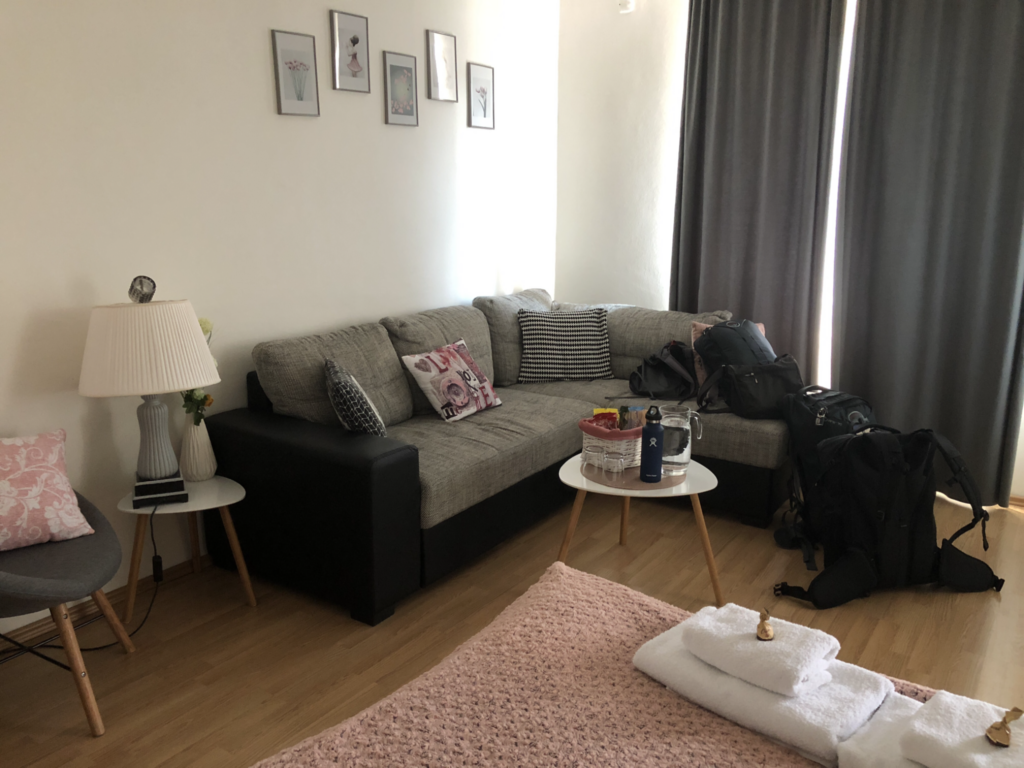
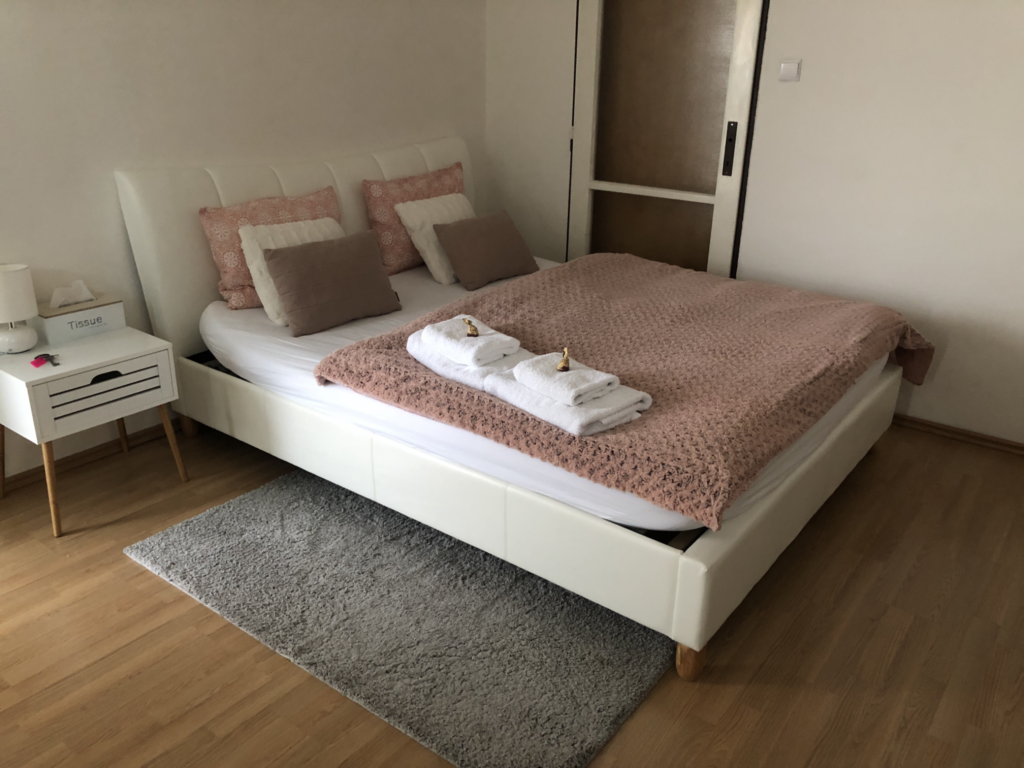
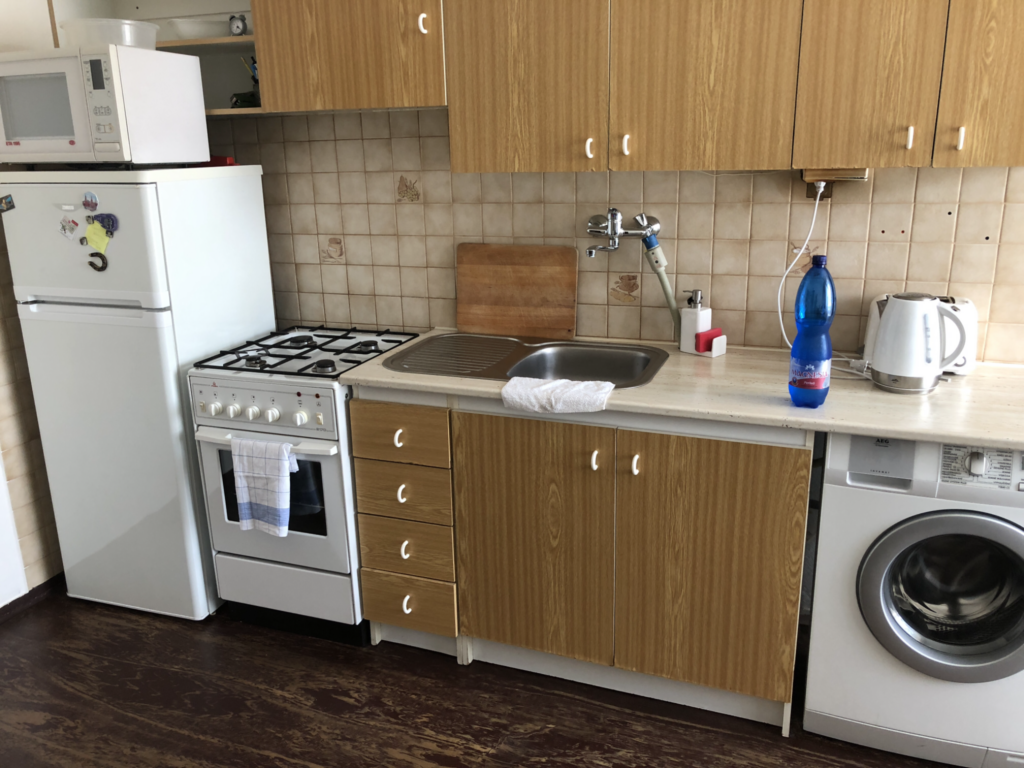

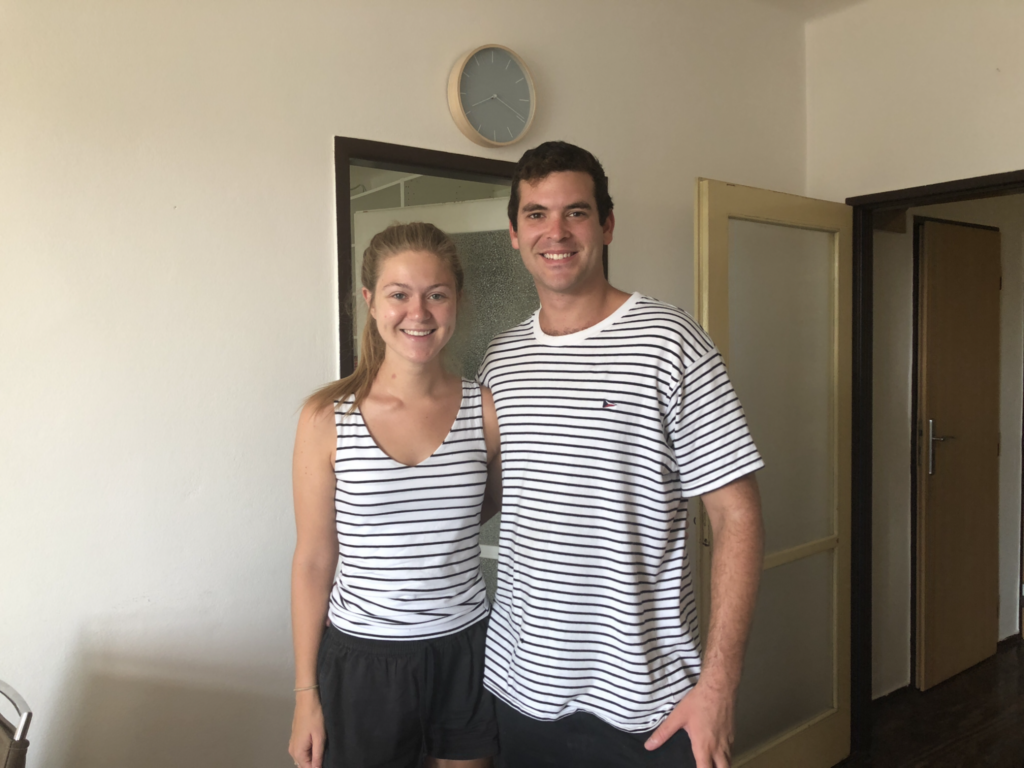
After staying in Dan and Jana’s living room for a few nights, it made sense to get our own place, as we planned to go back to “living as locals” for the rest of the two weeks we had scheduled. We booked an airbnb ($36/night) on the outer yellow line near Českomoravská, which was a fantastic set-up including our own room/living area and a shared kitchen and bath.
The hostess, Lucie, was top-notch and we’d highly recommend her place to anyone coming to Prague and looking for a more budget option than in City Centre. She even provided us with a little welcome basket of treats upon arrival and was very prompt and professional in handling any issues we had. Another thing we loved was having our own space, but being able to meet other couples that came through and stayed in the other bedroom. One of those couple was striped-matching and fun-loving Aussies, Sophie and Ryan, who we hit it off with immediately.
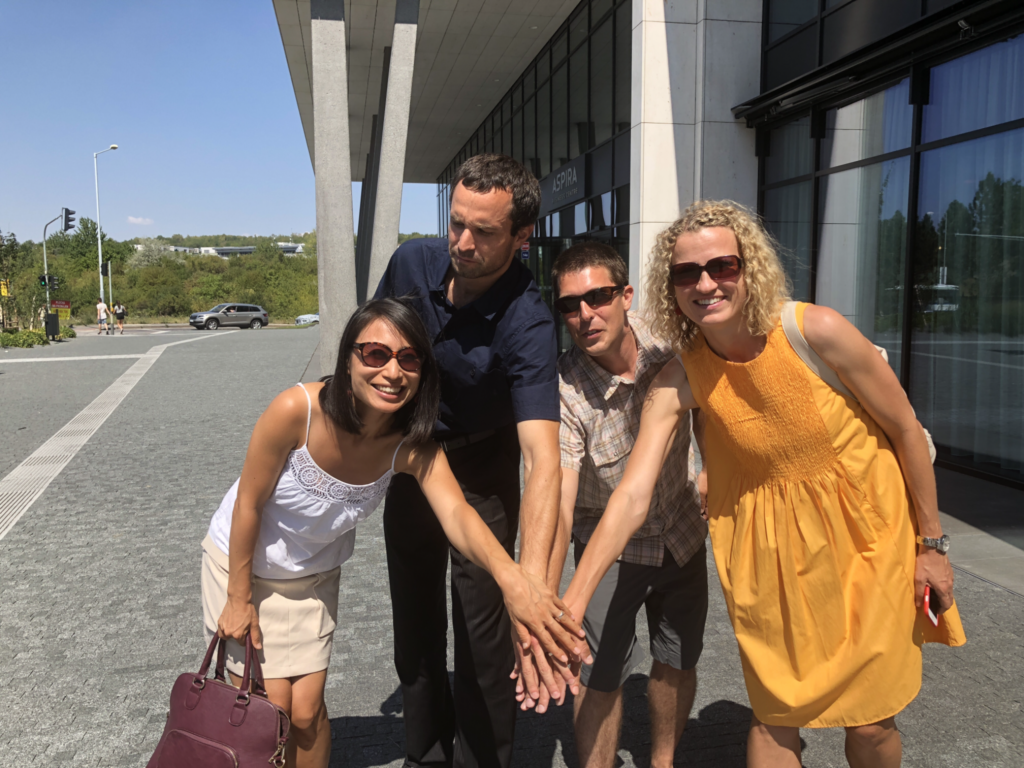
Meeting up with Greg’s friends and former colleague Kim, Theodore and Pavla, was a welcome treat.
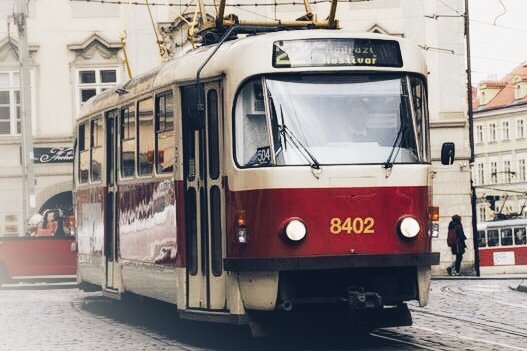
Off-the-Beaten-Path Prague
Most visitors to Prague who hop on the #22 only ride for a few stops, through Melostranska, Hradcany, or Old Town. But there is so much more to see and explore by settling into your seat, and simply riding from the end to end for 32 Czech Crowns ($1.40). We highly recommend riding the whole line to visit the tourist hot spots, which are obviously spectacular, as well as seeing some interesting out-of-the-way spots.
To get around Czechia, use the online public transport search engine IDOS search engine is invaluable: https://jizdnirady.idnes.cz/vlakyautobusy/spojeni/?lng=E
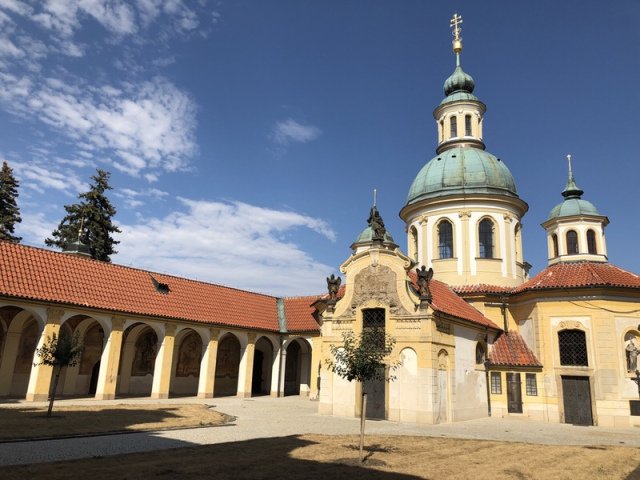
Bila Hora (White Mountain)
One such spot is Bila Hora, at the very western end of the 22 tram line. On November 8, 1620, the Catholic Habsburg army routed the Czech Protestants on this hillock outside Prague, deciding the fate of Bohemia for the next 300 years. What remains is a small memorial in a park, as well as the Church of our Lady of Victories.
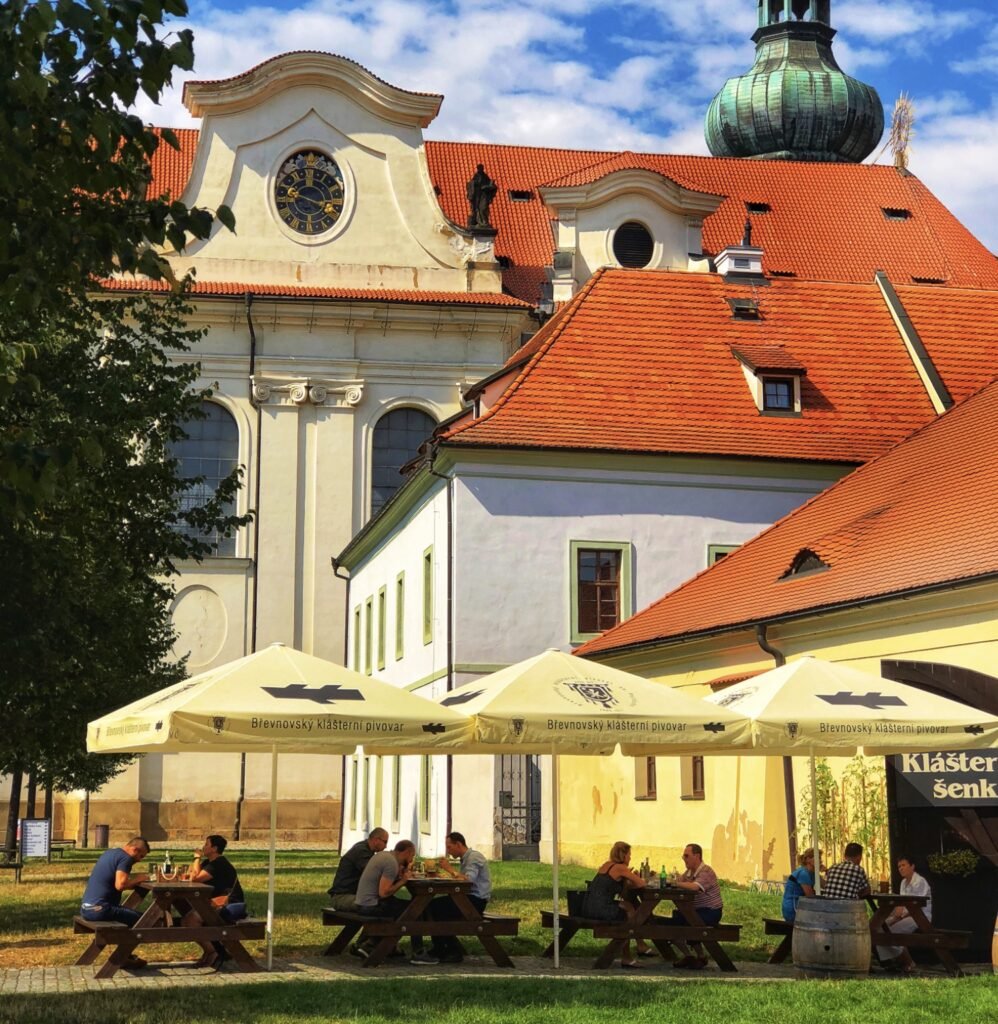

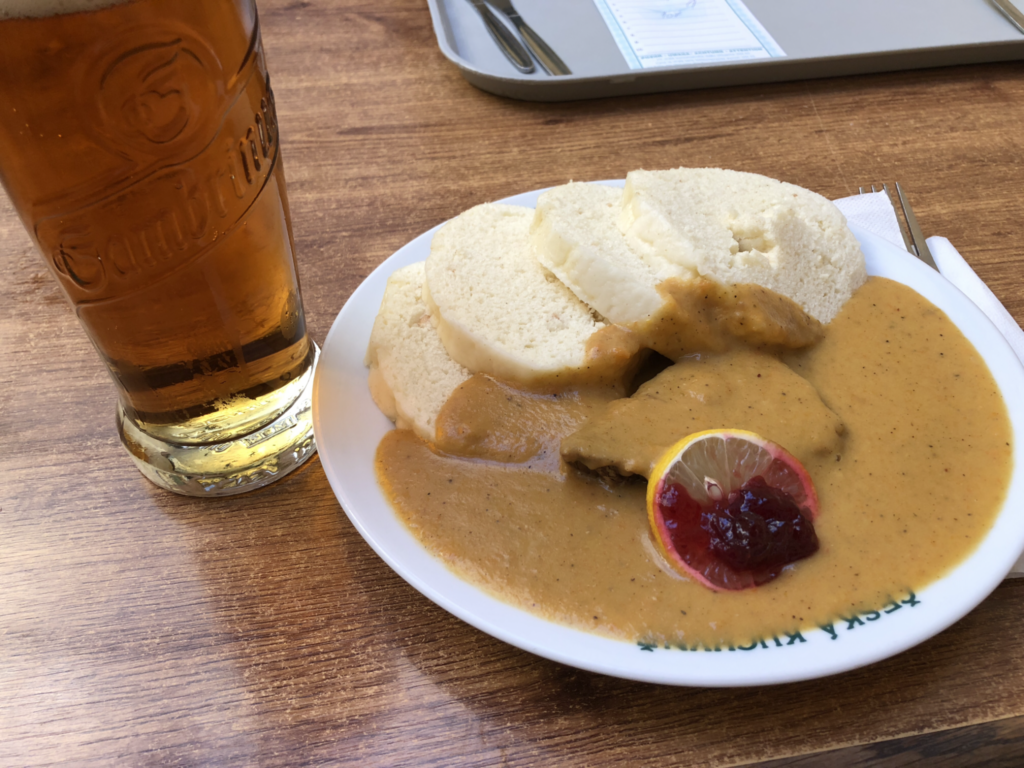
Břevnovsky Klaster & Pivovar (Brenov Monastery & Brewery)
A trip out to Prague 6 is worth it for this one, which also happens to be on the 22 tram line. This remarkable place was founded in 993 AD and was the very first Benedictine male monastery in Bohemia. The reason we were interested, however, is because it’s also where the oldest tradition of beer brewing in the Czech Republic originated. The prices were good, atmosphere was undeniably Czech, brews were mouth-wateringly delicious, and the food equally up to par.
We chose to indulge in our favorite Czech meal of Svíčková, beef sirloins in a root vegetable cream sauce served with dumplings. It’s often topped with cranberries, lemon, and in some cases a dollop of whipped cream. And yes, believe it or not, beef and whipped cream can coexist together beautifully!
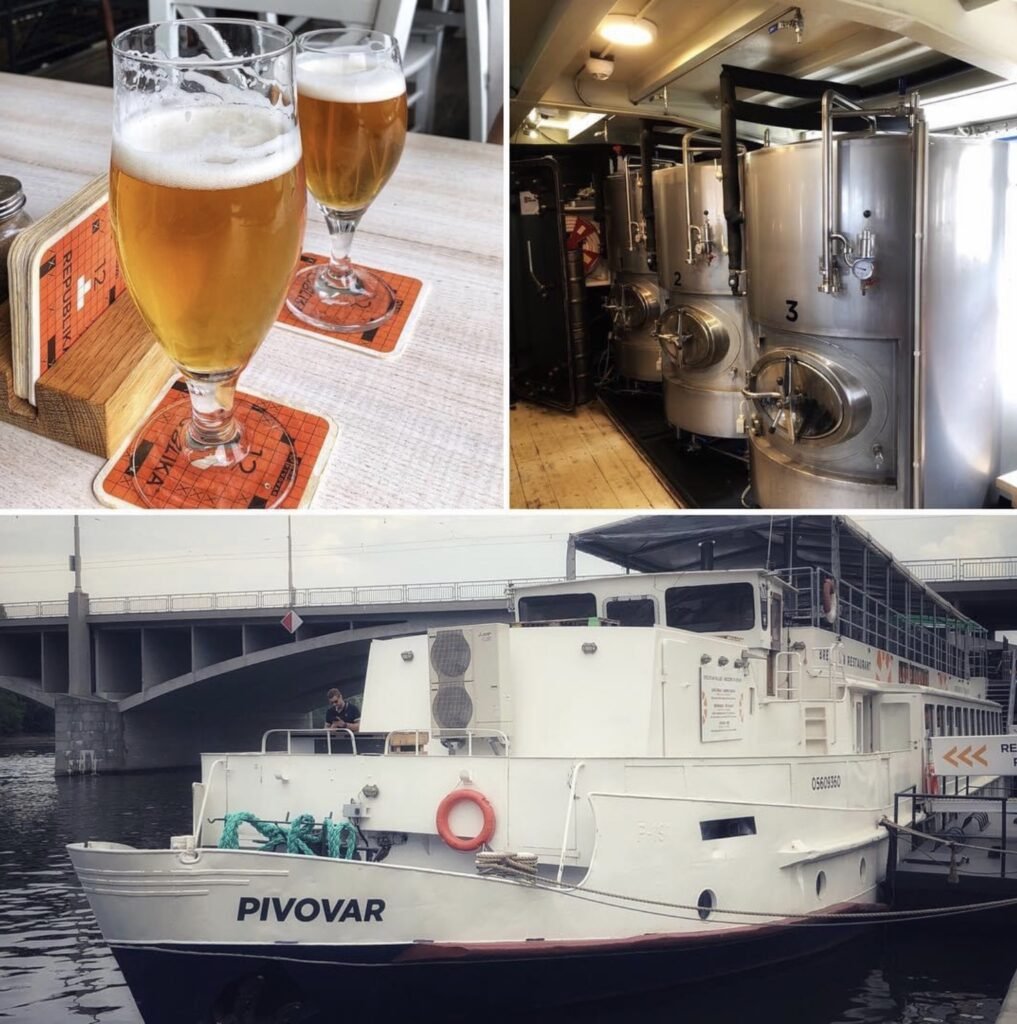
Lod Pivovar
Ever been to a brewery on a boat? Well, in Prague that’s a possibility at Lod Pivovar! This three-story boat features an outside terrace, live music, sustainably-sourced delicious food, and highly drinkable beers as well. Service is a bit slow, but worth it for the experience. Highly recommend!

We thought their bathroom signs were really clever too.
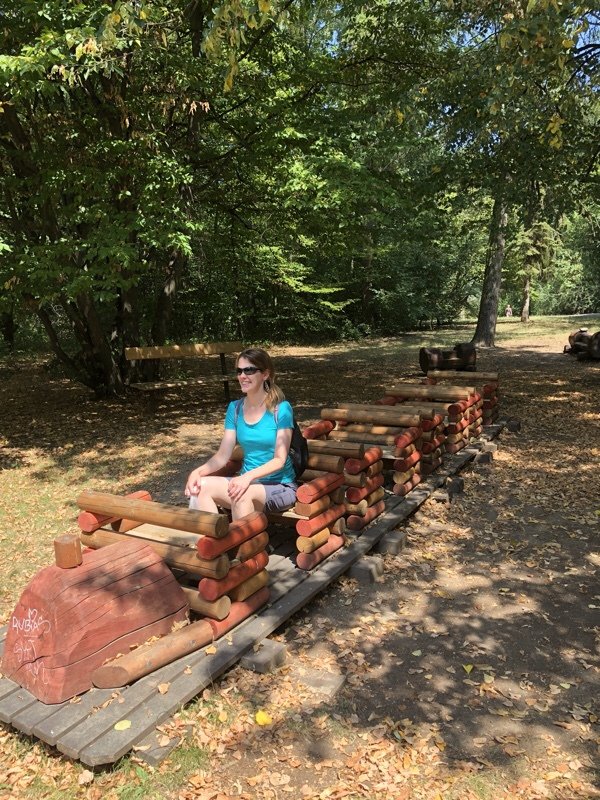
Hositvar Park & Lake
If you happen to be in Prague during the summer time, a great free swimming option is at Hostivar Lake. They also had really interesting Lincoln Log-style contraptions to hang out in. Okay, that weren’t that interesting…

Far more interesting, is the wonderfully swimmable lake itself. We packed a couple of (craft) pivos with chlebíčky (H-LEB-ITCH-KEY) (open-faced Czech sandwiches) and spent the afternoon lounging lakeside. Total cost…$6.50.

Džbán Lake
Another decent swimming hole in Prague is at Džbán Lake, which is out near Divoká Šárka Nature Reserve, also a fantastic stop. It costs 90kc (around $4.50), but is typically quiet and clean. Unfortunately, we didn’t get to stay too long this day because a massive thunderstorm cleared us out. We’ll never forget being among the hoards of swimmers squealing and running to the tram stop, being dumped on by mother nature, including sizable hail, and then everyone slipping and sliding aboard like drowned rats. Oh, these are the moments we wish we had pictures of!

Statue of King Wenceslas Riding an Upside-Down Dead Horse
This intriguing and abstract statue is in a very touristy area of Prague, yet most tourists don’t know to look for it. It’s inside the Art Nouveau Lucerna Palace (home of our favorite nightclub). The sculpture, created by David Černý is a mocking reference to the more famous equestrian statue of King (and later, Saint) Wenceslas that sits in Wenceslas Square, a few block away, and possibly a mocking nod to Czech president Vaclav Klaus, although the artist will not say what his intentions were (Atlas Obscura).
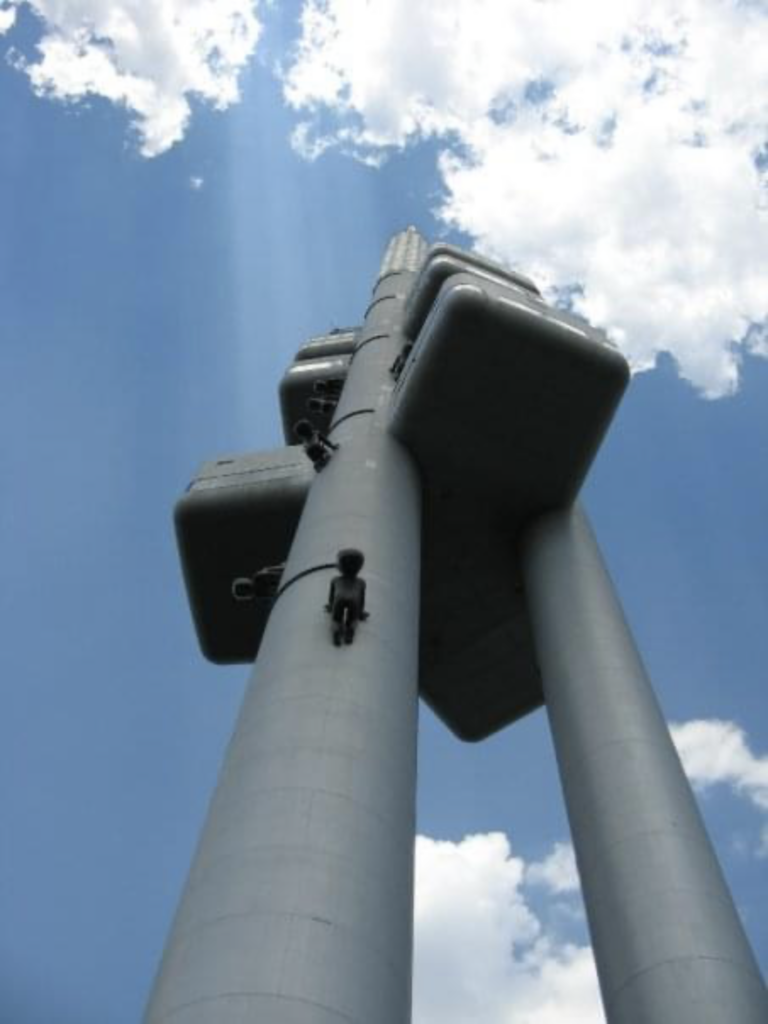
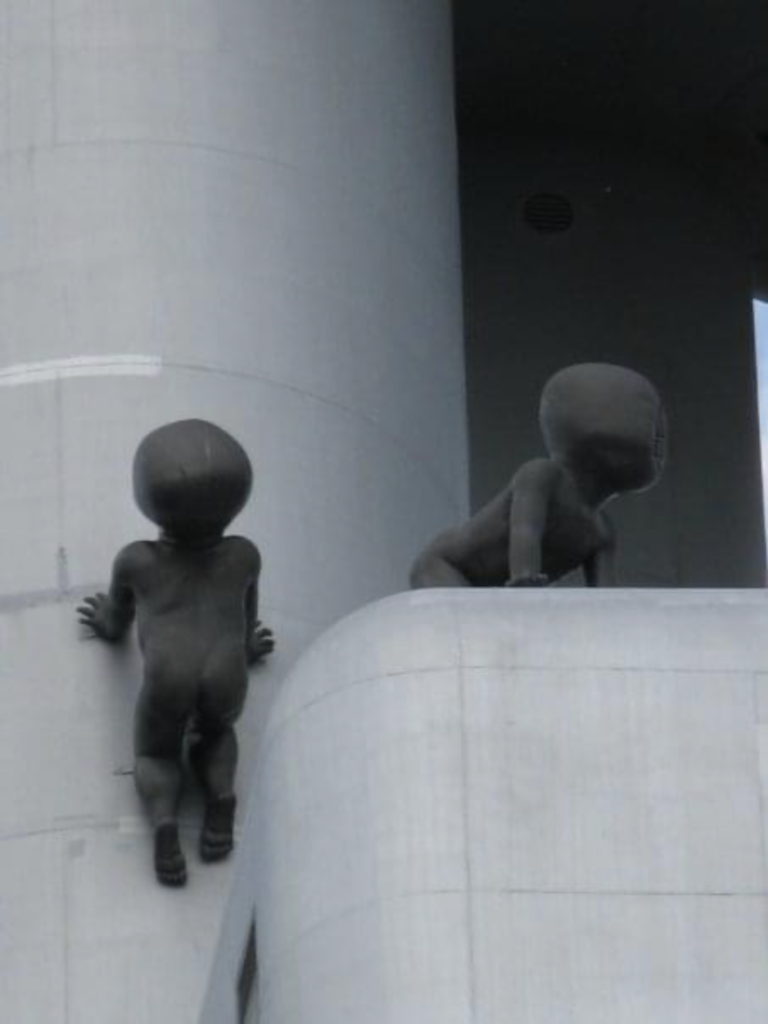
Babies of Žižkov Television Tower
David Černý has made his presence far more obvious in another place in Prague. Standing out from the picturesque skyline of the city, you’ll find… babies… scaling the sides of the television tower built between 1985 and 1992. These creepy babies with bar codes over their faces were added in 2000 and are also a symbol of the communist era, unable to reach adulthood, their growth stifled by this landmark of totalitarian rule.
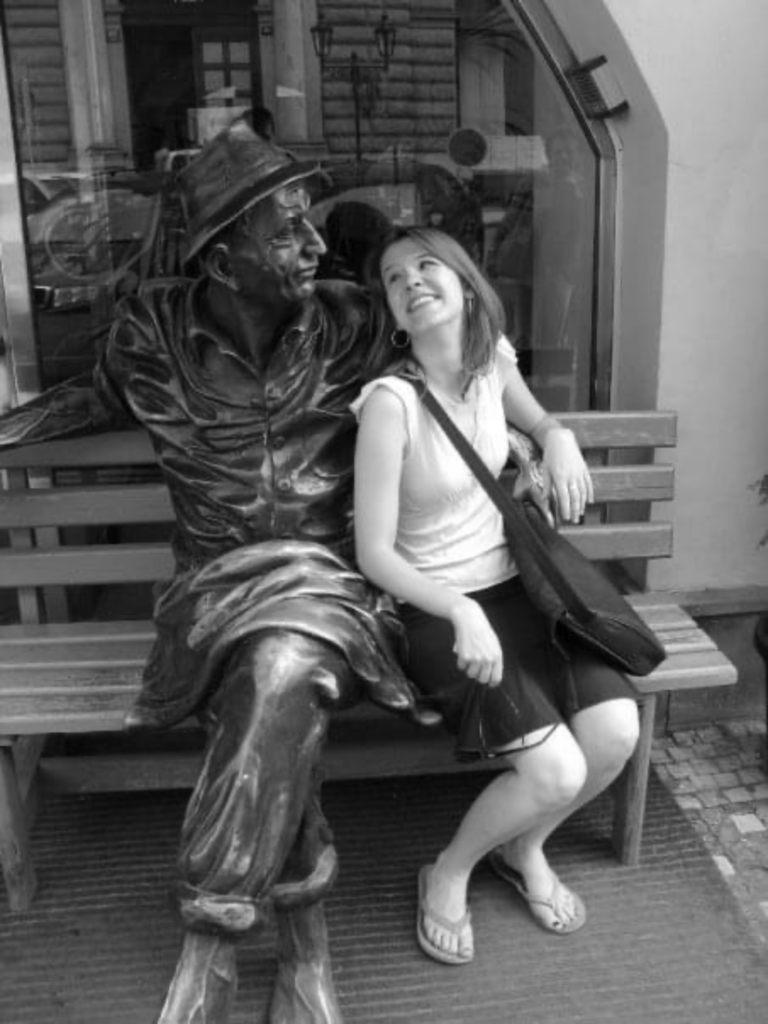
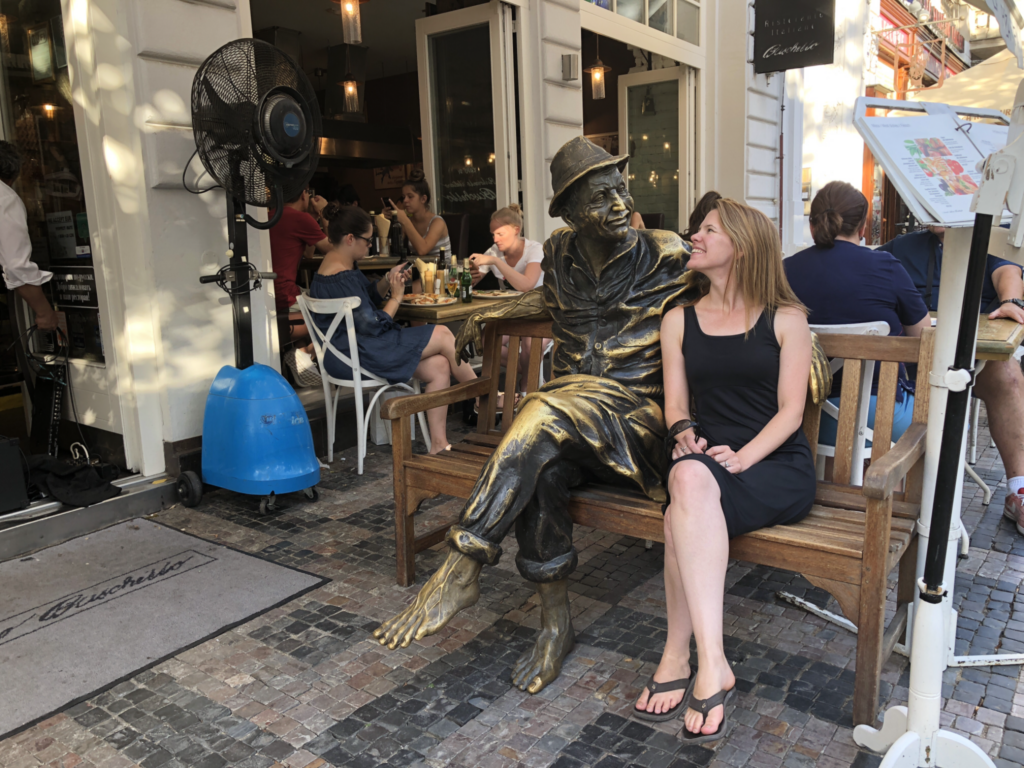
Mandy and the bronzed copper bench guy, in 2008 and 2018, the first one way more endearing.

Church of St. Ludmila at Namesti Miru
Underneath this exquisite church is where Mandy caught the metro everyday on her way to class.
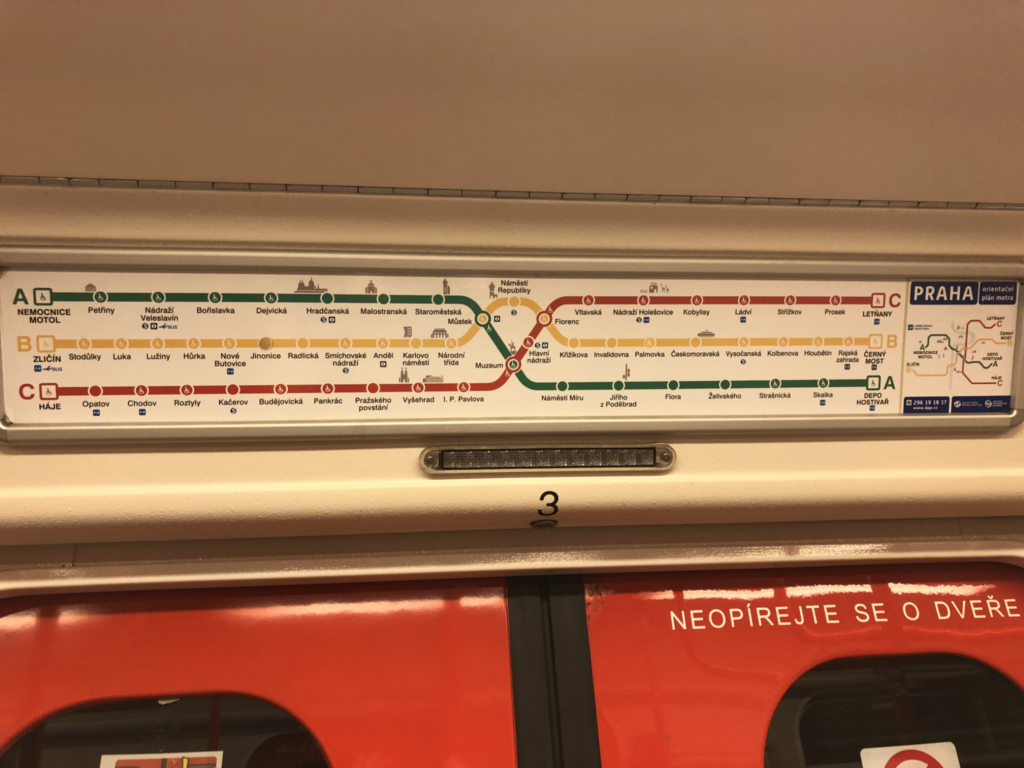
With only three color-coded lines and helpful pictures of tourist sights, getting around on Prague’s metro couldn’t get any easier. Probably one of the easiest of any major European city.
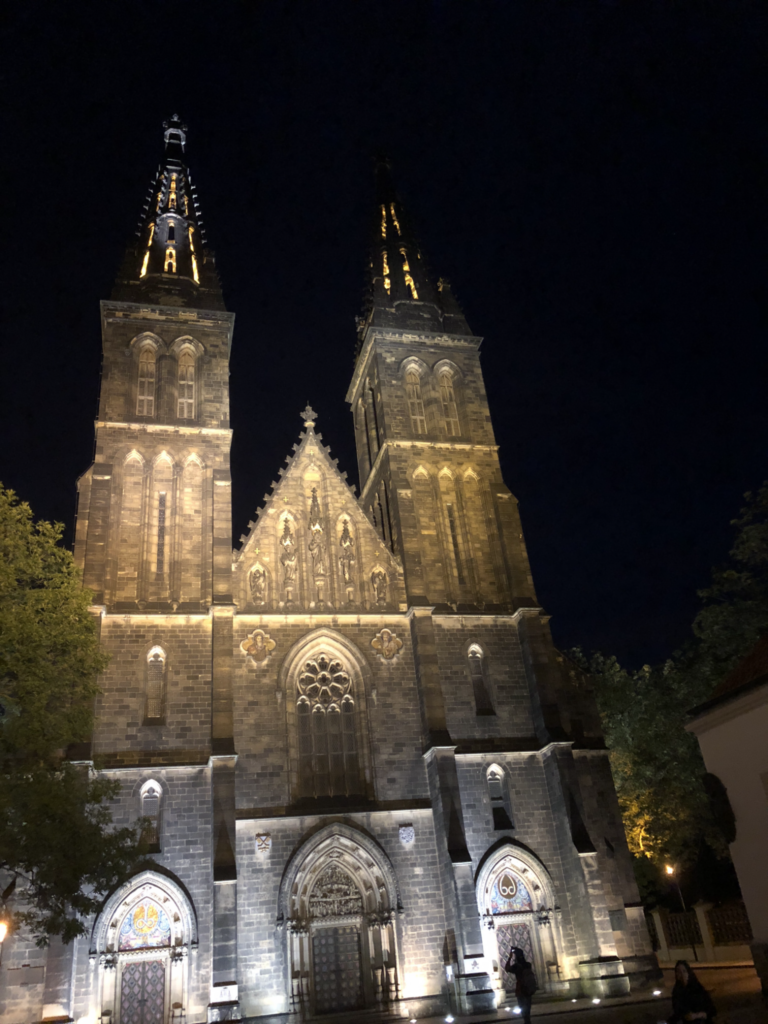
Basilica of St. Peter and St. Paul in Vyšehrad Castle
For four of his years in Prague, Greg lived directly underneath the castle walls of Vyšehrad, which is a historic fort with this stunning centerpiece built in 1070. He couldn’t resist showing off his neighborhood on our first date…one of our favorite memories is lying in his bed and hearing the bells from this church chiming above us. You couldn’t get more idyllic.
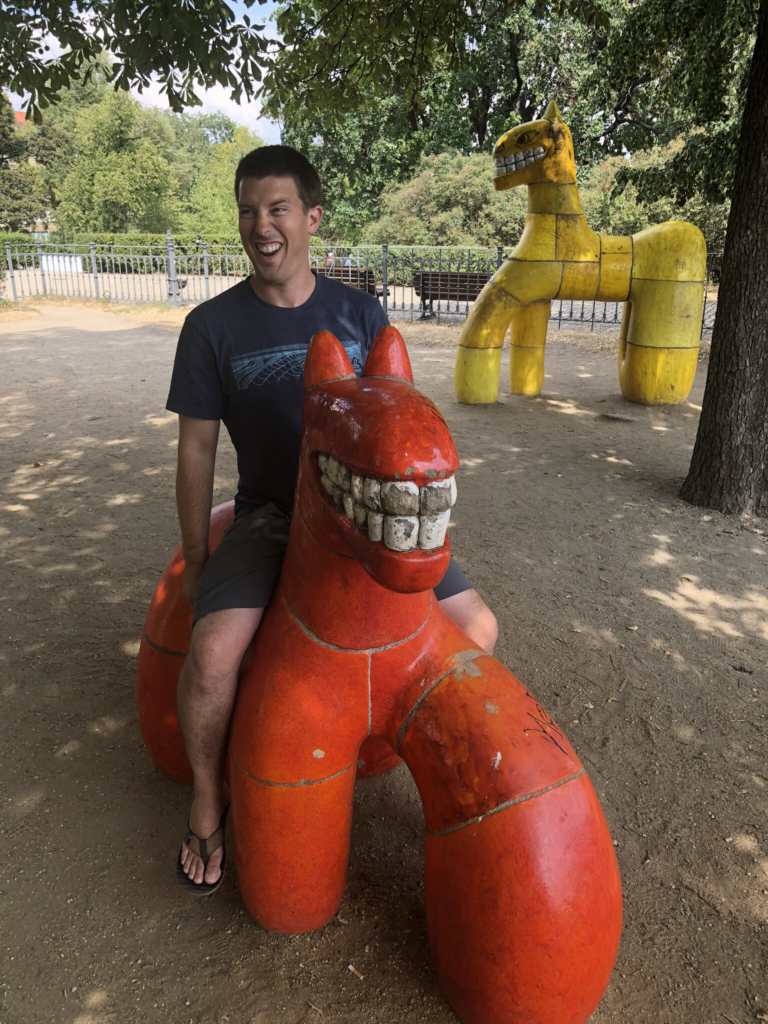
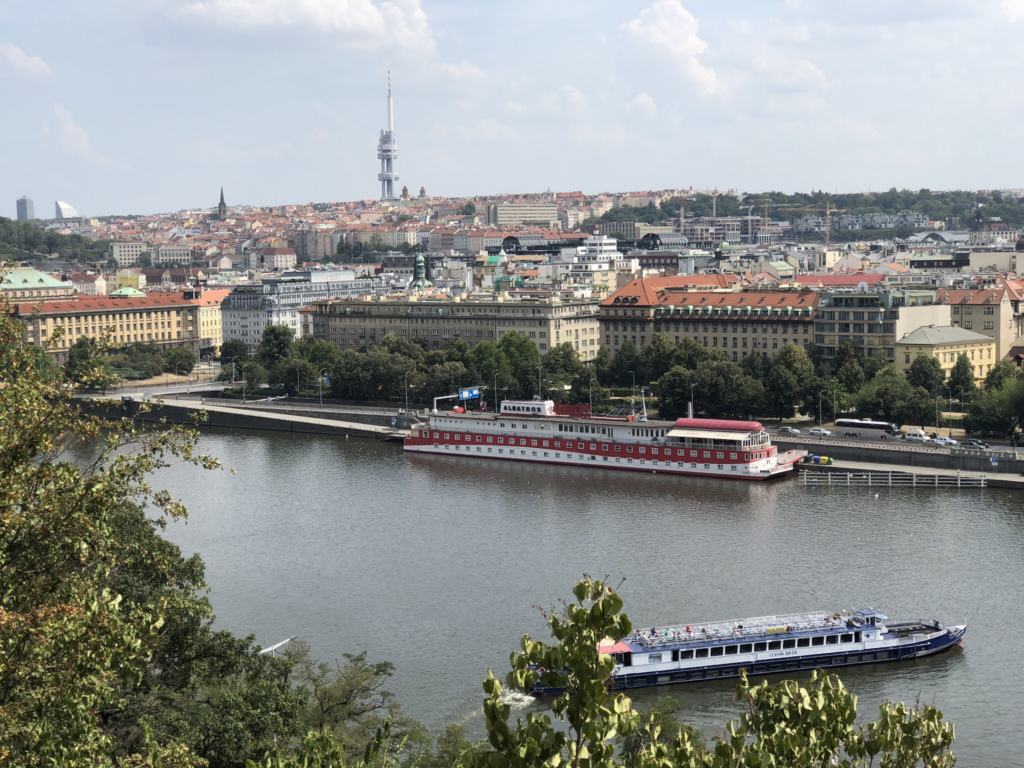
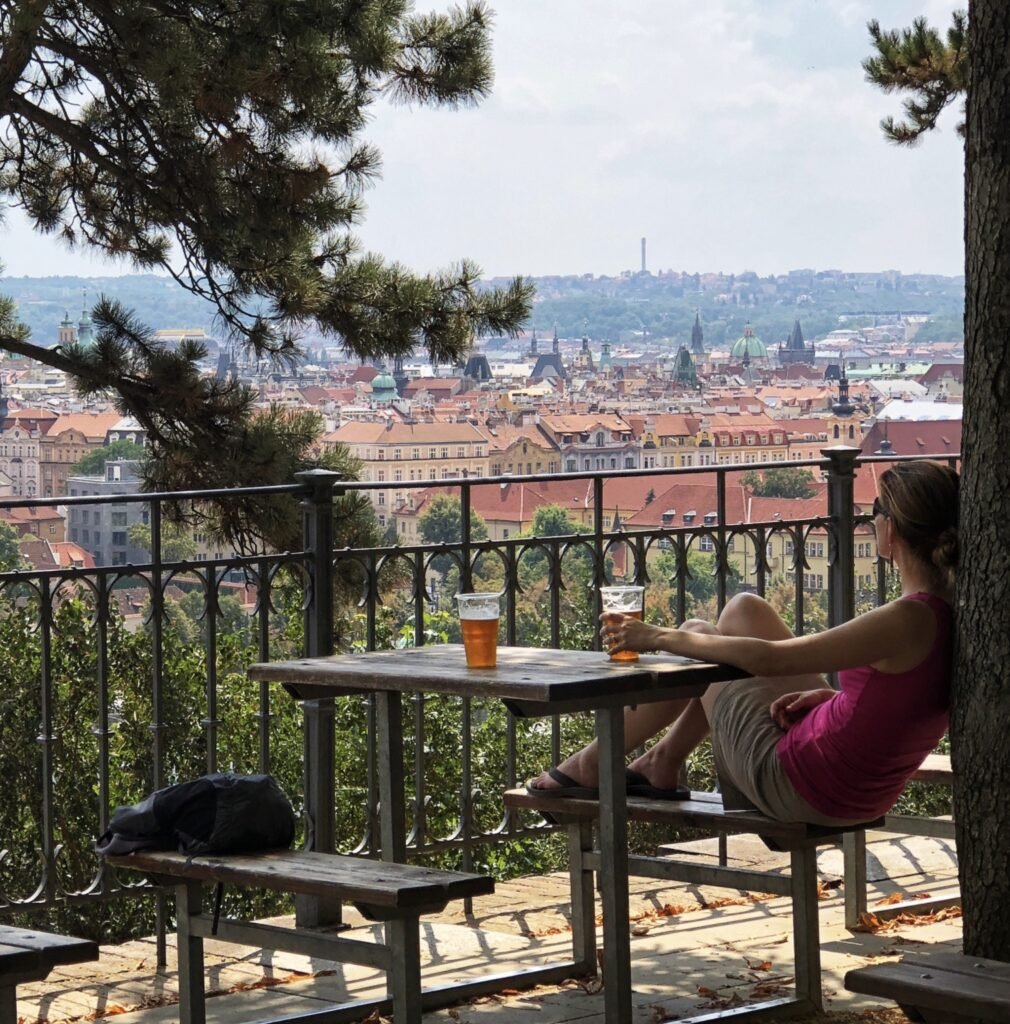
Letna Beer Garden & Park
One of the most popular spots for locals, and now tourists, to grab a beer is the Letna Beer Garden, requiring a tram ride on #12, 8, 25, 26, 1, 2, 14 to Letenské Náměstí. The views of the Old Town are phenomenal, the beer is equally as quaffable, and the park itself couldn’t be a better place to spend an afternoon walking, riding a bike or just lounging in the sun. Also, there’s weird things to climb on…

Prague Market
Although there are potravinys (small markets, often Vietnamese run) scattered everywhere throughout the city with inexpensive produce, one of the places we loved getting our produce was the Prague Market. Located in Prague 7, this lively marketplace is packed full of produce, cheese, flowers, herbs, spices and baked goods.

Not-so-Off-the-Beaten Path Prague
Prague had changed in the years we’d been away. It was more touristy than ever, particularly because we arrived in the bowels of summer…aka high tourist season. But, thankfully, we knew the trick to avoiding the madness. Hit Stare Mesto (Old Town) bright and early (aka sunrise) to soak in virtually empty streets and sights.

Charles Bridge
We were even able to enjoy Charles Bridge with a bit of solitude. In a few hours, the entire bridge would be jammed stone wall to stone wall with expensive cameras which will never get a good shot, Lonely Planet guidebooks, and tour group leaders stabbing umbrellas in the air. No thank you.


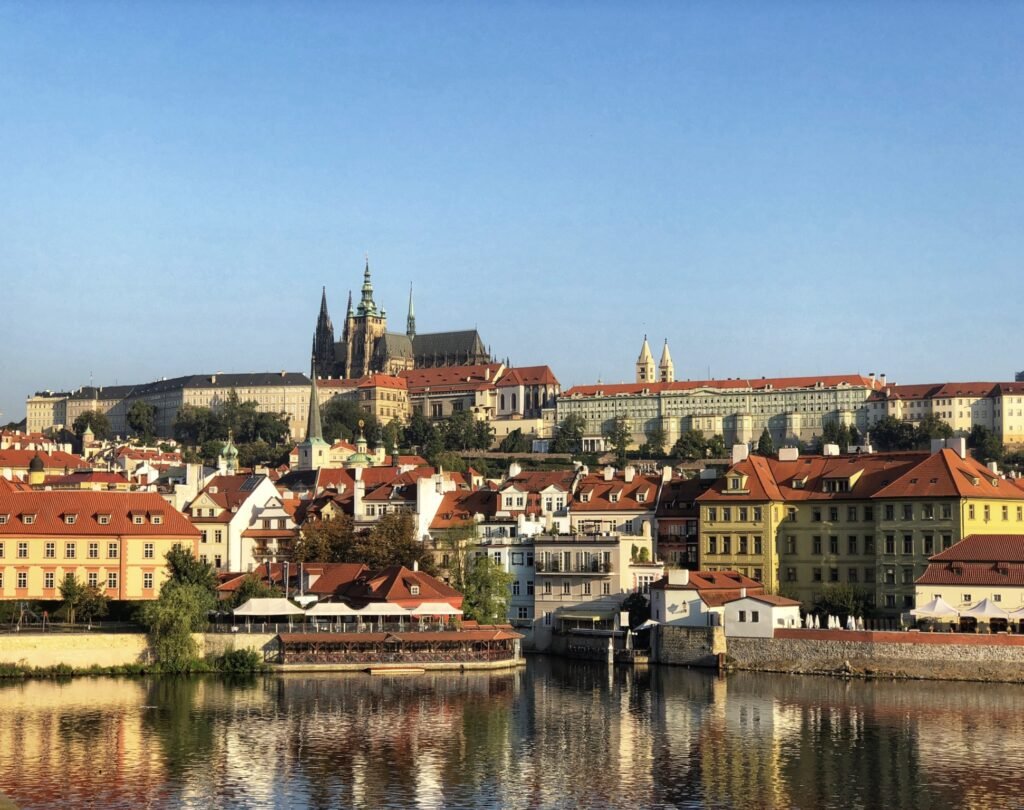
Charles Bridge…one of the most iconic and oldest medieval bridges in Europe built in 1357 by Charles IV. Interestingly, however, when it was built it was known as “Stone” or “Prague” Bridge and has only been called “Charles Bridge” since 1870. And until 1841 it was the only bridge over the Vltava River.
There are quite a few legends that surround the bridge. One is that, when it was built, the builders strengthened the bridge using raw eggs whipped into mortar. Historians have not come to any conclusive agreement whether it is true or not. But what is most likely a myth is the story being told – that there were not enough eggs in Prague, so that they were brought from every corner of the land and the inhabitants in one of the regions were afraid that the eggs would break during the transport, so that they sent them boiled – to the great amusement of the whole of Prague. (www.praguego.com)

The Vltava blanketed with paddle boats reaps an inviting summer night’s view of the famous bridge and castle. There is nothing quite like Prague in the summertime.
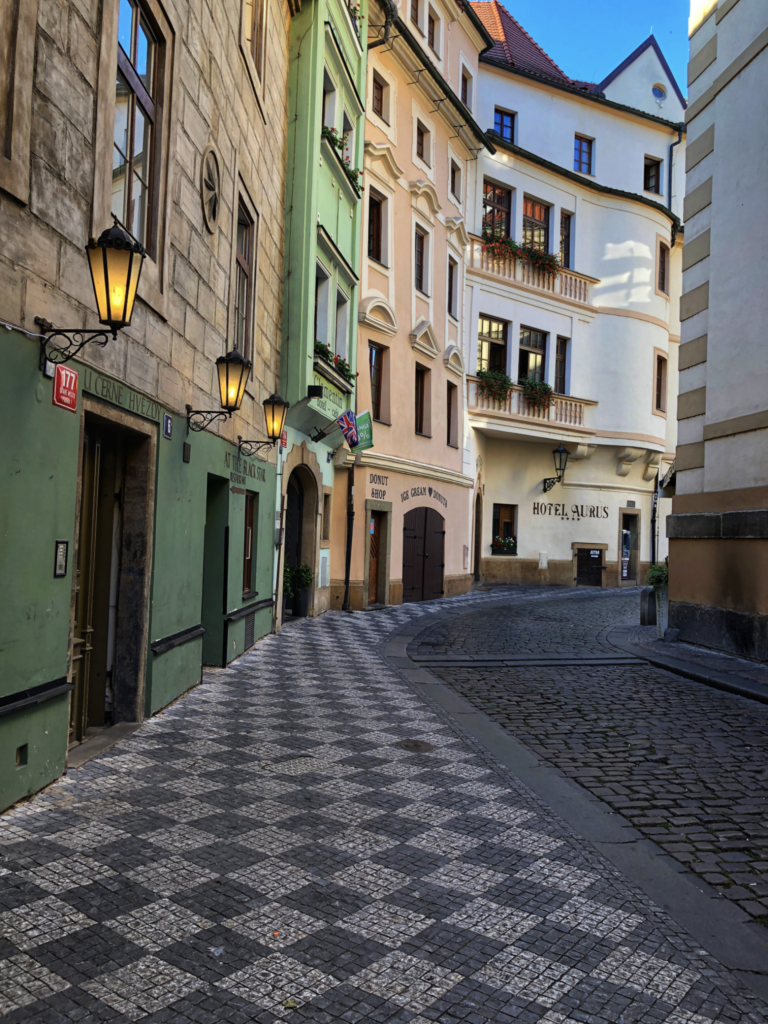
Other early morning moments of solitude.
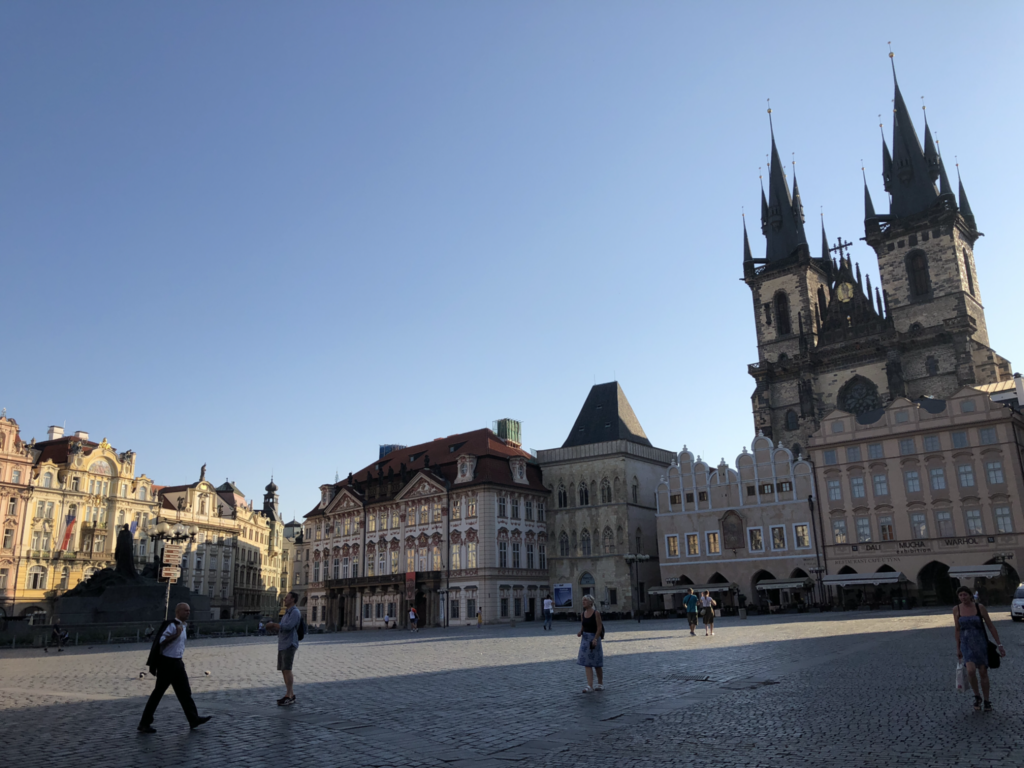
Staroměstské Náměstí (Old Town Square)
Old Town Square is fittingly the oldest in the city dating from 10th-century. Today the most grand of its structures is arguably the Church Our Lady before Tyn, which is a 14th century gothic landmark with 80 meter spire towers.
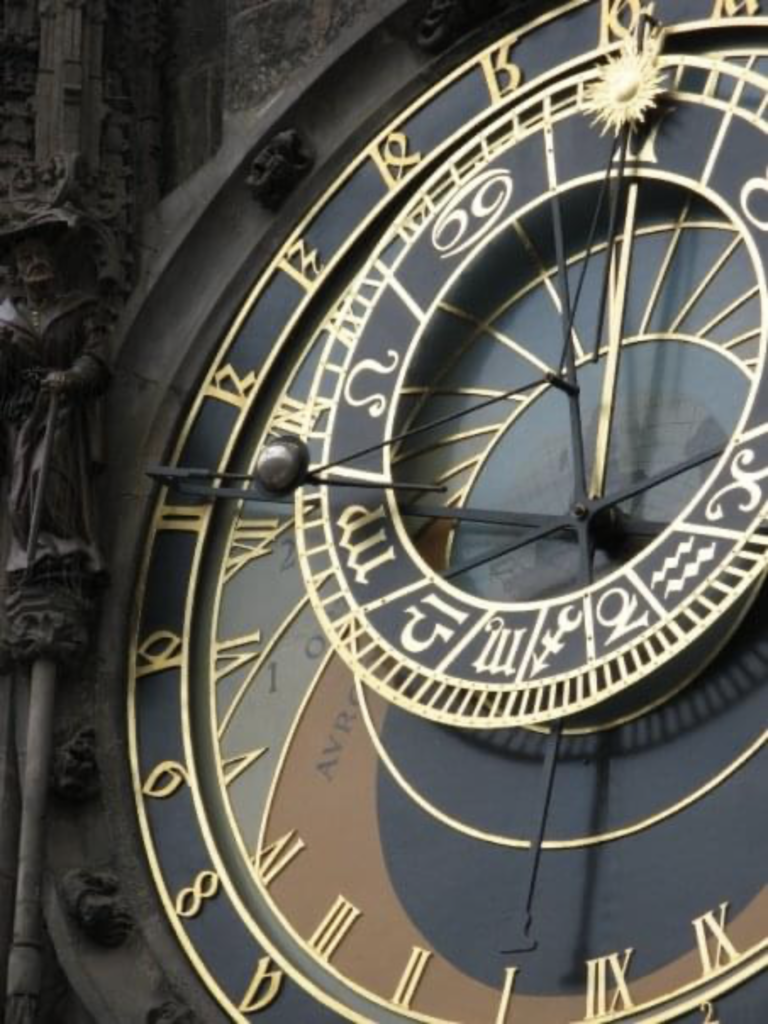
Prague Orloj
Also near here is Prague’s most notable site, which is the Astronomical Clock, which was built in 1410 and is the oldest astronomical clock still operating in the world. When we were there in 2018, it was covered in scaffolding, (because after 600 years, it’s understandable that it needed a facelift, pun intended), so we were glad to have our memories (and photos) from the past. Unfortunate for those tourists who were just visiting for the first time, however!
The Orloj is its actual name and the clock shows relative positions of the sun, moon, zodiac constellations and, sometimes, other planets. It also tells the time, the date, shows astronomical and zodiacal information, and, best of all, provides some theatre for its viewers on the hour, every hour. You can imagine the cell phone jams that happen.

The opposite view of Old Town Square. The astronomical clock is part of the tower you see pictured. You can also see the obtrusive face mask upon it.
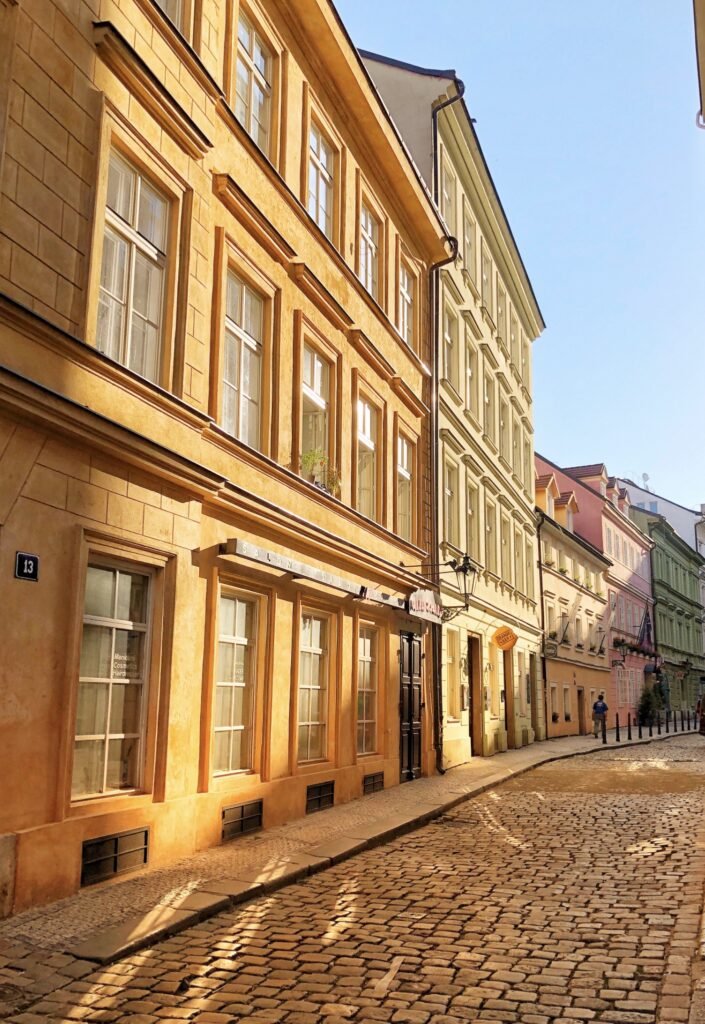
More vacant city streets. Love that sun-kissed hue.
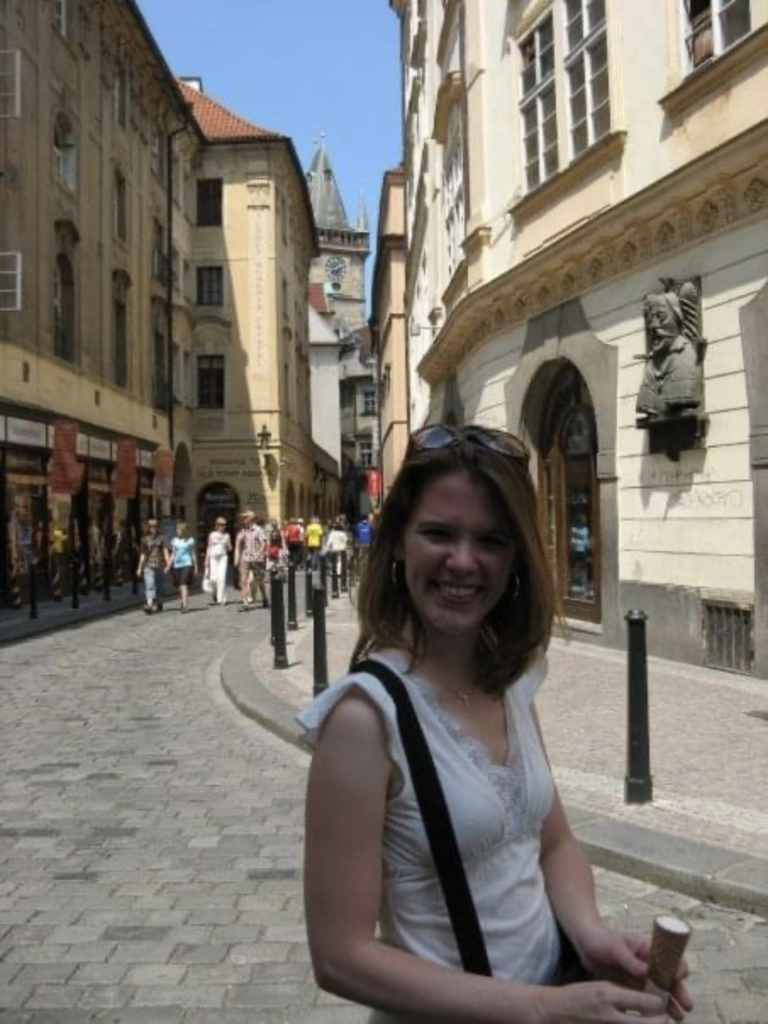
A couple blocks off Old Town Square, Mandy in May 2008.
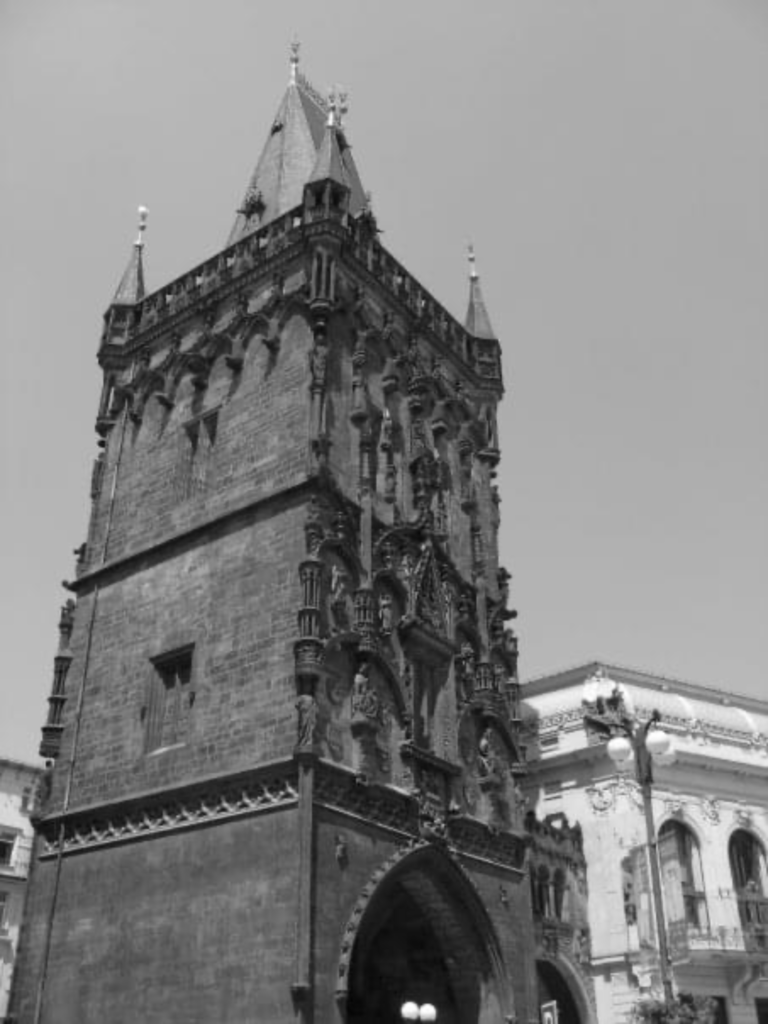
Powder Tower
Another popular tower in Prague is the Powder Tower, which is actually one of the original city gates, from 1475. The facade of it is obviously quite similar to the entrance to Charles Bridge. It was used to store gunpowder in the 17th Century, hence the name.

Svatováclavské Náměstí (Wenceslas Square)
The other most iconic square in Prague is Wenceslas Square, a majestic .7 kilometer long boulevard which is the center of “New Town” Prague. By new, we mean established in 1348 and was originally called the Horse Market, a massive trading post and market. It was renamed after St. Wenceslas in 1848.
This square has been home to a remarkable number of wind-changing demonstrations and events…the Nazis used the street for mass demonstrations, on January 16, 1969 student Jan Palach set fire to himself to protest the Warsaw Pact invasion of Czechoslovakia in 1968, during the Velvet Revolution in 1989 hundreds of thousands gathered here, and it’s where the masses gather on New Year’s Eve, which we experienced together in 2008.

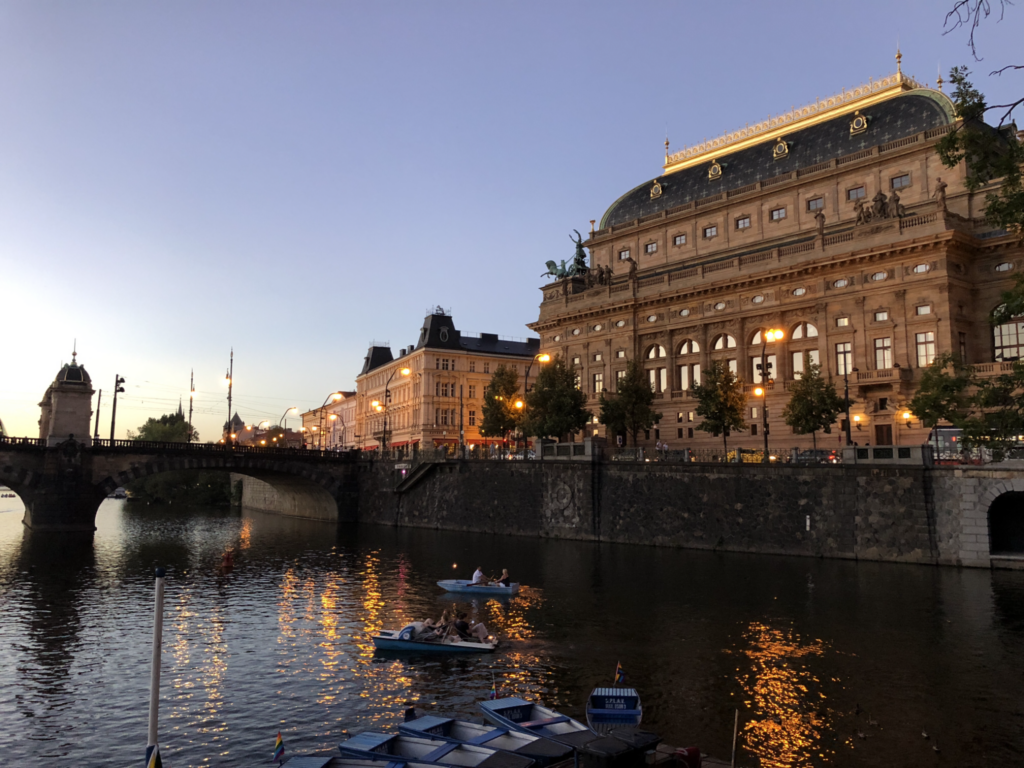
Vltava River Walk
You can’t get more romantic than walking along the Vltava River on a summer evening. We’ve done it some nights for hours upon hours.
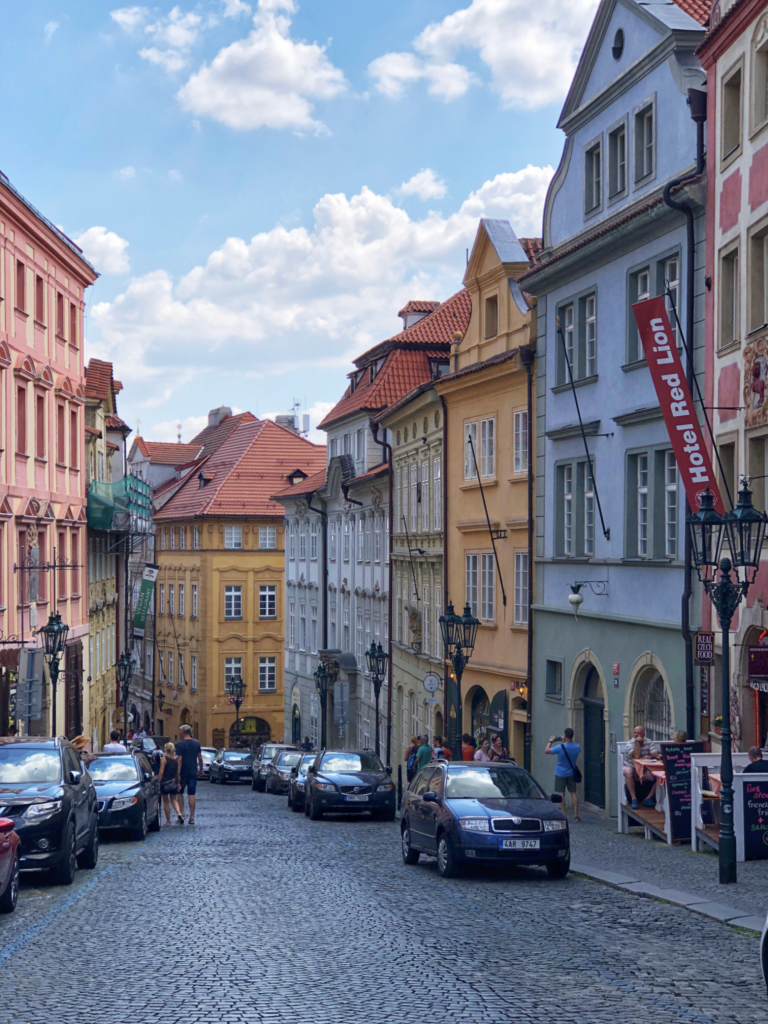
Just an average street scene near Prague Castle.
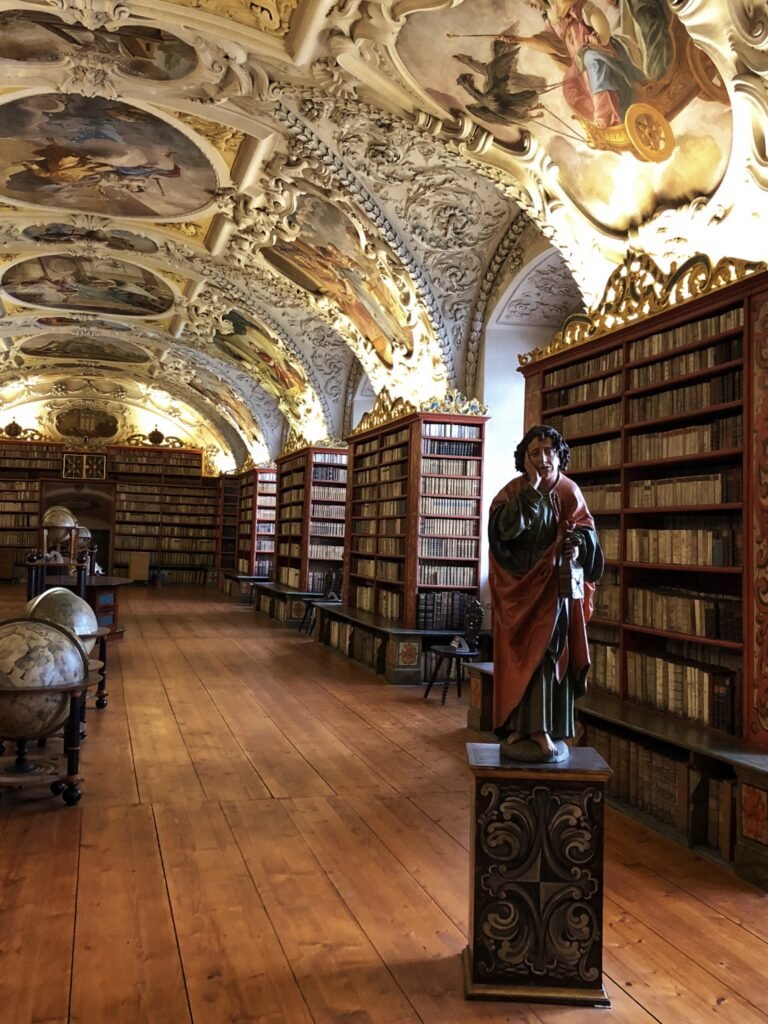

Strahov Monastery & Library
The Premonstratensian (followers of the teachings of St. Augustine) monastery was founded in 1140. The reason the mass of tourists flock here, however, isn’t to gaze at the church of the Assumption of the Blessed Virgin Mary. It’s to check out the Strahov Library, maybe one of the prettiest book lenders we’ve ever seen. Of course, the medieval manuscripts, maps and gloves houses here aren’t exactly on loan. Despite being ransacked by invading armies throughout the years, this 800-year-old library still houses more than 16,000 books. It costs 120kc to enter (about $5.50) and then they charge you extra to take pictures.
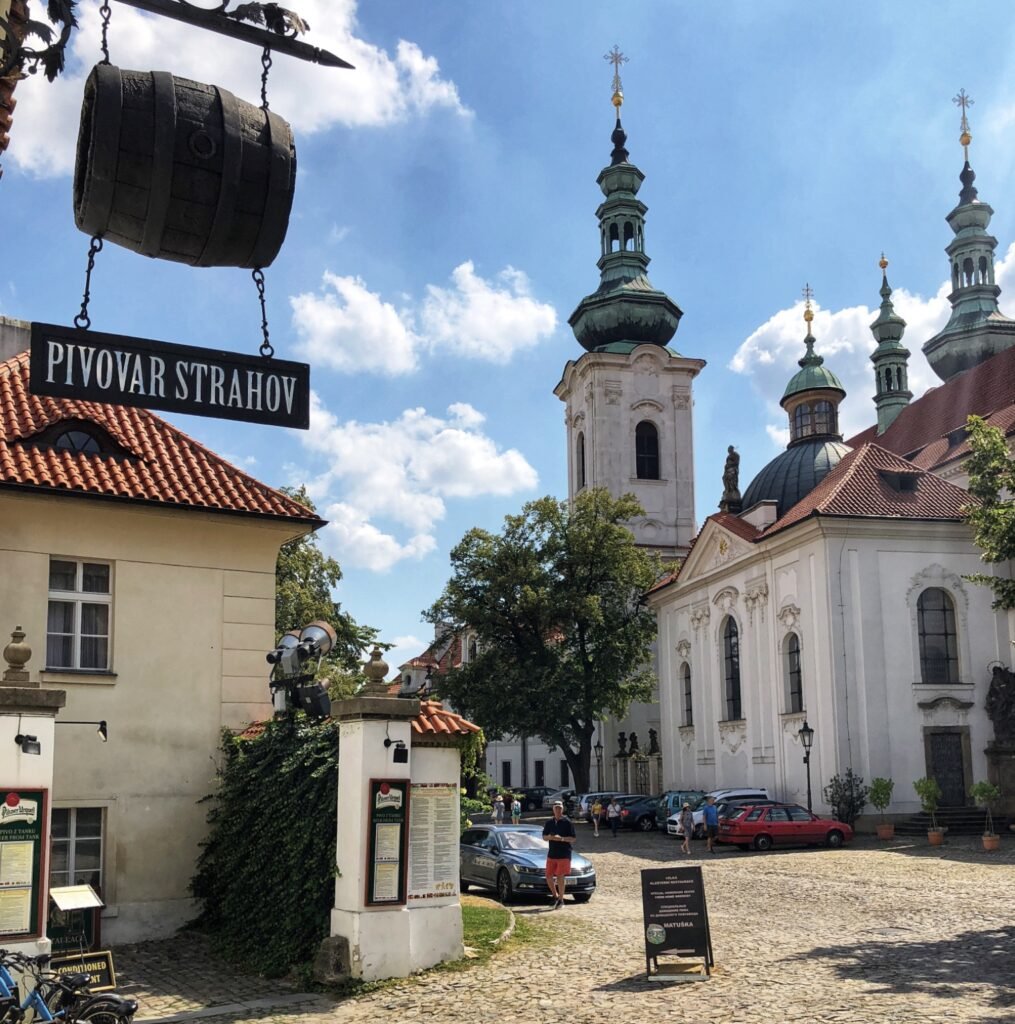
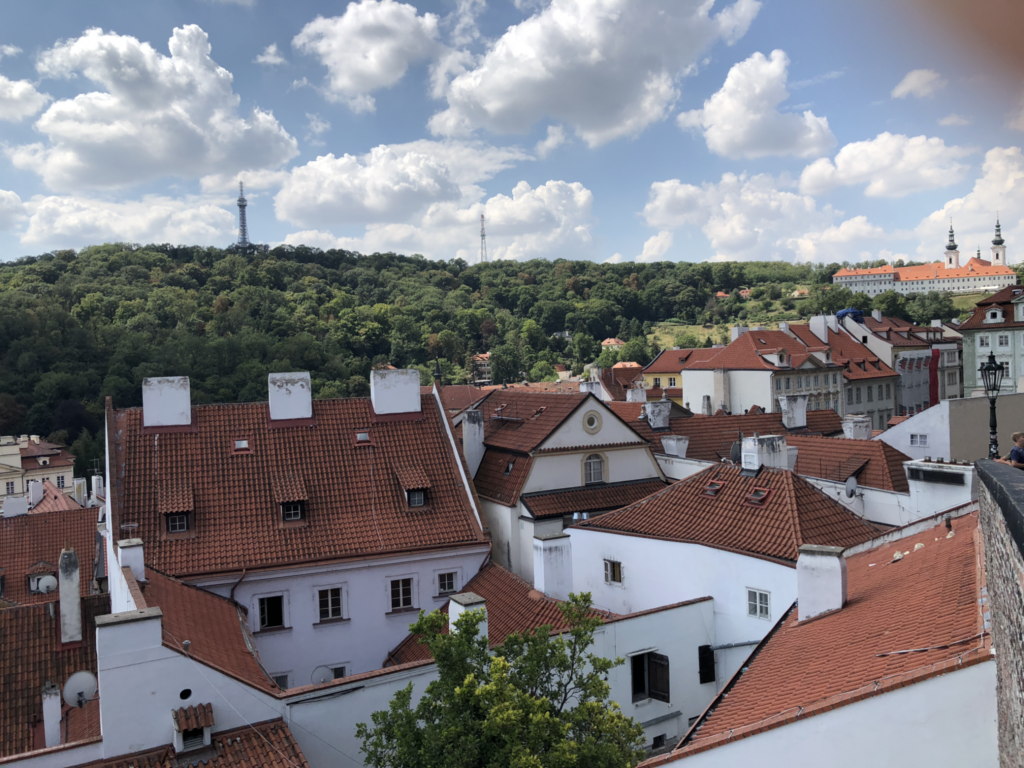
After you’ve gotten your fill of touristy havens, make sure to grab a look at the view from the monastery (you can see Petrin Tower from earlier), as well as grab a drink at Pivovar Strahov (The Strahov Brewery.)

Whether you decide to stay on the beaten path, or venture off, you won’t be disappointed in what Prague has to offer. Just make sure to allot at least five days to soak in its magic.

